You are using an outdated browser. Upgrade your browser today or install Google Chrome Frame to better experience this site.

Activities for Improving Balance
- By: Phillip Conatser , Juan Paredes , Danny Dominguez and Magalie Sanchez
- May 12th, 2017
Balance is often an overlooked skill to practice unless teaching or coaching gymnastics, the very young, or students who have disabilities that effect mobility. But maintaining and improving balance is essential for all students and should be a regular part of any PE, Adapted PE, or sports program. Adding a few balance skills during warmup takes little time and benefits other activities. For students with balance deficits, more time, emphasis, and practice can be allocated to improve balance. Some of these suggested activities and techniques will not only help improve balance but also athletic performance.
Balance Defined and Explained
Balance can be defined as an even distribution of weight that enables someone or something to remain upright while remaining stable and achieving equilibrium. In general, there are three main elements that help in achieving balance:
- Vision assists through input from the eyes and enables the body to understand its surrounding environment.
- Proprioceptors within the body react to changes in body position. The stimulus of balance or counterbalance receives input from these receptors in the base of the body, specifically in the feet, ankles, and joints. This system helps the body’s ability to sense movement of joints and limbs, ultimately, helping the body understand where it is in space while performing complex movements.
- The vestibular system , located within the inner ear, helps the body determine if the body is rotating or turning. This system is made up of three parts located in the ear; the utricle, saccule, and semicircular circles. Both the saccule and utricle help detect gravity (vertical information) and linear movement. The semicircular canals detect rotational movement and are filled with a fluid called endolymph. When a movement is performed, the body sends nerves impulses to the brain by way of the acoustic nerve. The impulse then sends a message to the brain to help the body understand where it is in space or the direction of movement.
Improving Balance
There are several ways to develop and improve these elements to help improve balance. The first method is to perform activities that stress these components through variability, while performing different movements. In the early developmental stages, such as infancy, children stress these components via different movements. Subtle movements such holding their head upright, sitting, crawling, standing, walking, and running can assist development. By engaging in balance activities such as standing on a “balance board”, walking on uneven grass, or performing gymnastics activities, the child will improve stability.
It is possible to increase the difficulty of these activities by removing visual cues or restricting the child’s ability in achieving balance: For example, performing balance activities or movement skills with closed eyes. By closing your eyes, it forces the body to use other balance system to counter balance issues. This will lead to improved balance when vision is reintroduced to the body. Through heightening one’s balance system or senses of awareness, the body will expand variability to accomplish movements in different environments. Other methods of stimulating the vestibular system include standing on a soft cushion or mattress. This will also confuse and stimulate the receptors within the foot and ankle.
When performing balance skills, it is possible to remove one, two, or even all three of these key elements of balance. For example, try standing on an uneven pillow or cushion, then immediately closing your eyes and tilting your head back. Observe how many seconds you can maintain your balance. You will find that standing steady under these conditions is very difficult. But with practice, performance will improve and will carry over to other activities that require balance.
In general, here are some techniques and skills and that could be performed to help improve balance.
- Mental concentration when performing a skill
- Moving to an uneven beat or doing movements in an unusual pattern
- Movements crossing mid-line and in opposition
- Non dominant eye or hand activities
- Increase muscular strength and endurance
- Postural control skills
- Unstable surfaces
- Unstable swings and moving
Here are some examples of exercises and progressions that stress and can improve balance
Wall Push-Up : Stand in front of a wall with feet together and arms extended, so that only your finger tips are touching. Descend into the wall until arms are bent to 90 degrees, then push yourself into the standing position. If you are unable to perform the concentric motion, step closer to the wall and progress from there. The goal is to perform the movement at an arms-length away from the wall. Once you have mastered the wall push up, lift one leg up and repeat the same progression.
Quadruped Push-Up : From the quadruped position (on all fours with hands under shoulders and knees under hips keeping a flat back), lower your upper body to the floor until your arms are bent at 90 degrees. Press yourself back up to starting position. If you are unable to push yourself back, descend slowly to 90 degrees (counting 5s) and push as far back up as possible, then reset yourself to the starting position.
Knee Push-Ups : From the quadruped position, walk your arms forward to where your legs make a 45-degree angle from the floor. If you are unable to push yourself back to the starting position, descend slowly to 90 degrees (counting 5s) and push yourself back up as far as possible, then reset to the starting position.
Regular Push-Up : From a standard push-up position lower yourself to 90 degrees then push yourself back up, keeping your body straight. If you are unable to push yourself back up, descend slowly to 90 degrees (counting 5s) then revert to your knees and push yourself back up to Knee Push-Up position
- Front Knee Raises
Bent Knee : Stand next to a chair, and raise your knee as high as possible and maintain it in position for 1s and alternate legs Once you can maintain it for 1s with ease increase the time to 5s then to 10s. Use the chair as needed. Add ankle weights to progress further.
Straight Leg : Stand next to a chair and, keeping your leg straight, raise it as high as possible and maintain the position for 1 second and then alternate legs. Once you can perform the movement for 1s with ease increase the time to 5s then 10s. Use the chair as needed. Add ankle weights to progress further.
- Side Leg Raises
Bent Knee : Stand next to a chair, and bend your knee and maintain it at 90 degrees. Move your knee to the side and maintain it in position for 1s and alternate legs Once you can maintain it for 1s with ease increase the time to 5s then to 10s. Use the chair as needed. Add ankle weights to progress further.
Straight Leg : Stand next to a chair and, keeping your leg straight, raise your leg to the side and maintain the position for 1 second and then alternate legs. Once you can perform that for 1s with ease increase the time to 5 s then 10s. Use the chair as needed. Add ankle weights to progress further.
- Sit to Stand
Stand up Without Support : From a sitting position, stand up without support. If you are unable to stand up, use the armrest support and with as little arm support as needed stand up. If you are unable to stand use a taller chair, to limit the range of motion. If you need another person’s assistance to stand, from a standing position sit down slowly (5s decent), then 10s as it becomes easier. Progress from a taller chair to a shorter chair as you improve.
Weighted Sit to Stand : Once you are able to sit to stand without support with ease, add a weighted vest or load.
Unilateral Sit to Stand : From a sitting position, lift yourself up without support using only one leg. If unable to stand with only one leg begin in the standing position and use a single leg 5s eccentric, then 10s as it become easier and you can stand. Return to the standing position using both legs.
Weighted Unilateral Sit to Stand : Add weight and from the sitting position, lift yourself up without support.
- Calf Raises
Both Leg Raise : While standing next to a chair, lift your heels as high as possible and hold for 5 secs, then come back down. Once you can perform this with ease hold for 10s, 20s, then 30s. Use a chair for balance as needed.
Unilateral Calf Raise : Place the toes of your right foot next to your left ankle. Then lift your left heel off the ground and hold for 5s, then alternate feet. Once you can perform this with ease hold for 10s, 20s, then 30s as you progress. If you are unable to lift your heels of the ground with only one foot, lift both heels off the ground and lift your right foot off the ground and place it next to your left ankle. Use a 5s descent, then 10s as it becomes easier until you can perform the movement.
- Chair Leans
Sitting Lean : From a sitting position, sit up with your back straight and lean towards your knees with a 5s eccentric, maintaining your back straight. If you are unable to bring yourself back up use your hands or forearms to push yourself back up, using as little support as possible, until you can do it without help from your hand/forearms.
Raised Arm Chair Lean : From the sitting position, sit up with your back straight and raise one of your arms overhead. Lean your torso forwards towards your knees, while maintaining your arms in line with your back. Use a 5s eccentric and then progress to a 10s eccentric. Once you are comfortable, lift both your arms and follow the same progression.
Standing Lean : While standing in front of a chair, place your arms on a chair. Bend your body forward as far as possible, while maintaining a small bend in your knees. Use your arms for balance, but if needed to help yourself back up. Begin by bending to approximately 45 degrees then progress to being parallel to the ground. Use a 5s eccentric and progress to 10s eccentric once you have mastered the 5s eccentric.
- Single Limb Stances
Stand with feet together and arms at the sides or reached outward. Lift one leg (a) in front of the other “L” stand, (b) behind the other “airplane” stand, or (c) to the side “Y” stand while balancing on the other leg (repeat other side). Movements need to be slow and rhythmical, raise as high as posable, and hold 2-20 seconds each. For support a chair could be used.
- Tandem or Staggered Stance
Stand with feet together with arms at sides or reached outward. Step forward with your right foot heel touching your left foot’s toes (Hold for 2-10 seconds). A chair may be used for support. Alternate by using other foot in front.
Start with four or more soft cushions on the floor spaced out twelve to sixteen inches apart (stride length). Try to walk on each cushion without any pauses and a smooth rhythmical pattern. Cushions can also be used to walk over (lunges) with pauses between each step.
Start in the standing position, arms at the sides, and feet together. Step across in front of your left foot with your right leg. Continue to step sideways in a crossing pattern for a set distance and then reverse the pattern on the way back. For added support, use the wall, hold instructor’s hand, or arm crutches. To increase difficulty, increase movement speed, distance, and/or a knee bend during the crossover.
- Heel to Toe
Start by standing with one foot in front of the other. Step forward, slowly swinging the leg around until it is placed inline and touching the other foot. Can hold partner’s hand for support or increase leg swing height (arc) for more difficulty. Closing eyes and/or tilting head upward will also increase difficulty.
Start with both feet even and bring right or left foot backward a set distance (mark with tape) then return to the original stance. The arms can be extended frontward to help maintain balance. Chair or wall can be used for stability and making the backward step larger with arms held to the side can make the activity harder.
Additional Fun Balance Activities
Note : Add variability (eyes closed/open, dominant/non-dominant limbs, fast/slow, rhythmical/arhythmical, etc.)
- Wheelbarrow Walking
- Gymnastics Balance Beam Skills
- Stepping Stones
- Riding a Unicycle
- Tumbling (Head Stand & Hand stand)
- Body awareness activities like Yoga & palates
Remember increasing your balance ability is not just for gymnasts or student with disabilities, it will also help improve overall performance in physical education, sports, and life!
— Contribute an Article on HPE —
Contact: [email protected]
What activities do you do that require balance? Please answer and reply.
Thank you. – Crystal Johs
Join the Discussion

- Pete Charrette
Improving Balance in PE: Strategies and Activities for Kinesthetic Awareness
In the realm of human movement, two crucial elements in physical education are balance and kinesthetic awareness. Balance allows us to maintain stability, while kinesthetic awareness enables us to understand how our bodies move in space. Together, they form the foundation for physical competence and a stronger mind-body connection, contributing to overall well-being.

Physical education is often undervalued as merely a break from academics, but it is essential for holistic growth. Balance and kinesthetic awareness are not limited to the gym; they are fundamental in various aspects of life. They improve efficiency, reduce the risk of injury, and boost confidence in sports, daily activities, and recreational pursuits. This article sheds light on the significance of these skills, their multifaceted benefits, practical tips for incorporating them into physical education, and effective techniques to enhance students' physical and mental well-being.
Understanding Balance in PE: Static and Dynamic Balance
Balance, in the context of physical education, pertains to the ability to maintain one's body equilibrium, whether at rest or in motion . This equilibrium could either be static balance or dynamic balance.
Static balance refers to t he ability to maintain a stable position when the body is not in motion . It is evident in actions like standing on one leg or maintaining a certain pose. On the other hand, dynamic balance relates to the ability to stay balanced while the body is in motion - for instance, while walking on a balance beam or hopping backwards on one foot.
Balance is the result of a complex interaction between multiple body systems: visual inputs, vestibular (inner ear) inputs, and proprioception or body sense. The central nervous system continuously processes these inputs to help us maintain our body equilibrium.

Kinesthetic Awareness: The Body Sense
Kinesthetic awareness, also known as body sense, is the perception of the positions and movements of our body parts, even without looking at them. It's our brain's ability to sense our muscles and joints' relative positions, movements, and tension. This awareness plays a critical role in coordinating our movements and maintaining our balance, whether static or dynamic.

Improving kinesthetic awareness can greatly enhance our physical skills, agility, precision, and safety during physical activities, from performing a dance routine or playing ball sports to typing on a keyboard without looking at the keys.
Benefits of Incorporating Kinesthetic Awareness and Balance Movements in Physical Education
The practice of kinesthetic body awareness and balance movements offers numerous advantages for both physical and mental well-being. A few of these advantages encompass:
1. Enhanced Sports Performance : Incorporating balance and kinesthetic awareness in PE classes improves sports performance. It's easier to excel in sports such as soccer, basketball, or gymnastics when students have good balance and body awareness.
2. Injury Prevention : Good balance and body awareness can help students avoid injuries. For example, being able to maintain balance can prevent falls and sprains during PE classes or sports activities. Similarly, enhanced body awareness can help students perform movements correctly and safely, avoiding the strains or sprains associated with incorrect form.
3. Improved Motor Skills : Balance and kinesthetic awareness are vital for motor skill development. Motor skills, which include both fine (small muscle) and gross (large muscle) movements, benefit greatly from a student's ability to know and control their body's movements.

4. Cognitive Development : Balance and kinesthetic awareness stimulate the central nervous system, which can boost brain development. This can lead to improved concentration, memory, and learning abilities in students.
5. Increased Confidence : As students improve their balance and body awareness, they can become more confident in their physical abilities. This confidence can translate into better performance in sports, dance, martial arts, or other physical activities.
6. Promotion of an Active Lifestyle : Students with better balance and body awareness are likely to enjoy physical activities more, leading to a more active lifestyle. An active lifestyle has numerous health benefits, including better cardiovascular health and decreased risk of obesity.

7. Better Coordination : Good balance and kinesthetic awareness improve coordination, which is the ability to use different parts of the body smoothly and efficiently together. Better coordination can make physical activities easier and more enjoyable.
8. Life Skills Development : The skills developed through balance and kinesthetic awareness activities are not only applicable to sports but to life in general. Balance is required for activities as simple as walking or standing on a moving bus. Kinesthetic awareness can make tasks like cooking, typing, or dancing easier and more efficient. These are skills that students will carry with them throughout their life.
Does Implementing Balance and Kinesthetic Awareness in PE Help Meet Required Standards?
Indeed, integrating balance and kinesthetic awareness activities in physical education can significantly help meet the necessary standards for student achievement. These are crucial components of physical literacy, playing a vital role in overall health and well-being. Incorporating balance and kinesthetic awareness aligns with SHAPE America Standard 3 , which states: The physically literate individual demonstrates the knowledge and skills to achieve and maintain a health-enhancing level of physical activity and fitness.

Tips for Implementing Balance and K.A. Lessons in PE
Below are 10 tips for PE teachers in implementing balance and kinesthetic awareness activities in physical education classes for elementary, middle, and high school students:
1. Understand Individual Differences : Recognize that students will have varied levels of balance and kinesthetic awareness. Assess their abilities early on, and plan activities that can be adapted to meet different skill levels. This ensures that all students can participate and be challenged without feeling overwhelmed or bored.

2. Create a Safe Environment : Safety is paramount. Check the floor or ground for any obstacles or slippery surfaces that might cause accidents. Ensure that all equipment like balance beams or balls is in good condition and appropriate for the students' age and ability. Creating a secure environment encourages students to explore their balance without fear of injury.
3. Start with Fundamentals : Introduce basic exercises first, focusing on static balance, such as standing on one leg or walking on a straight line. As students become comfortable, gradually increase the difficulty by adding dynamic balance exercises, like hopping backwards or maneuvering through obstacle courses.
4. Use Appropriate Equipment : Utilize equipment that promotes balance training. Balance balls, balance beams, and even simple props like scarves for juggling can add variety and challenge to your lesson plan. Ensure that these tools are suitable for the age group and skill level of your students.

5. Incorporate Technology : If resources permit, using technology like video analysis can help students visualize their movements and understand where improvements can be made. This kind of immediate feedback can significantly enhance kinesthetic awareness.
6. Engage through Games and Fun Activities : Transform exercises into fun games or challenges that encourage students to practice balance and kinesthetic awareness. Creating a playful and engaging environment not only promotes learning but also fosters a love for physical activity.
7. Provide Continuous Feedback : Continuous, constructive feedback helps students understand their body mechanics and make necessary adjustments. Encourage students to also be mindful and self-aware of their movements, guiding them to correct themselves.
8. Promote Peer Collaboration : Encourage students to work in pairs or small groups, where they can support each other and provide additional feedback. Collaborative activities like partner balancing or synchronized movements can foster teamwork and enhance balance and kinesthetic awareness skills.

9. Encourage Regular Practice : Balance and kinesthetic awareness are skills that improve with consistent practice. Design homework exercises that students can safely perform at home, and encourage them to practice multiple times to reinforce what they've learned.
10. Integrate Real-world Applications : Show students how balance and kinesthetic awareness are used in everyday life and various sports. Whether it’s maintaining balance while riding a bicycle or knowing the position of the arms while swimming, real-world applications make the lessons more relevant and engaging.
Balance and Kinesthetic Awareness Example Movements
Here are 12 examples of balance and kinesthetic awareness (shown with fitness task cards) that can be incorporated into your physical education lesson:
Balance Push-Up: Get in a push-up position and balance a beanbag on your back. Do some pushups or hold a plank position.

Shoulder Stand: Sit in an “L sit” position on a mat. Put your arms by your sides and roll back until your body and legs are straight up in the air. Prop up on the back of your shoulders.
Balance Sit: Balance a beanbag on your head while standing. Slowly sit down and then stand back up again while balancing.

2 Point Balance: Find a place on a mat or floor to balance. Get in a balance position using 2 body parts and hold the position as long as possible (e.g.. left leg and right arm).
Step Through: Balance a hula hoop on the top of your head. Slowly step through the hoop one foot at a time. Step back through.

V Sit Balance: Sit down on a mat or floor in a “pike” position with your legs our front. Simultaneously, lift your legs and your arms up in the air to form a “V” shape.
Log Roll: Lay sideways with your arms by your sides. Keep your body tight and straight. Roll sideways all the way down the mat.
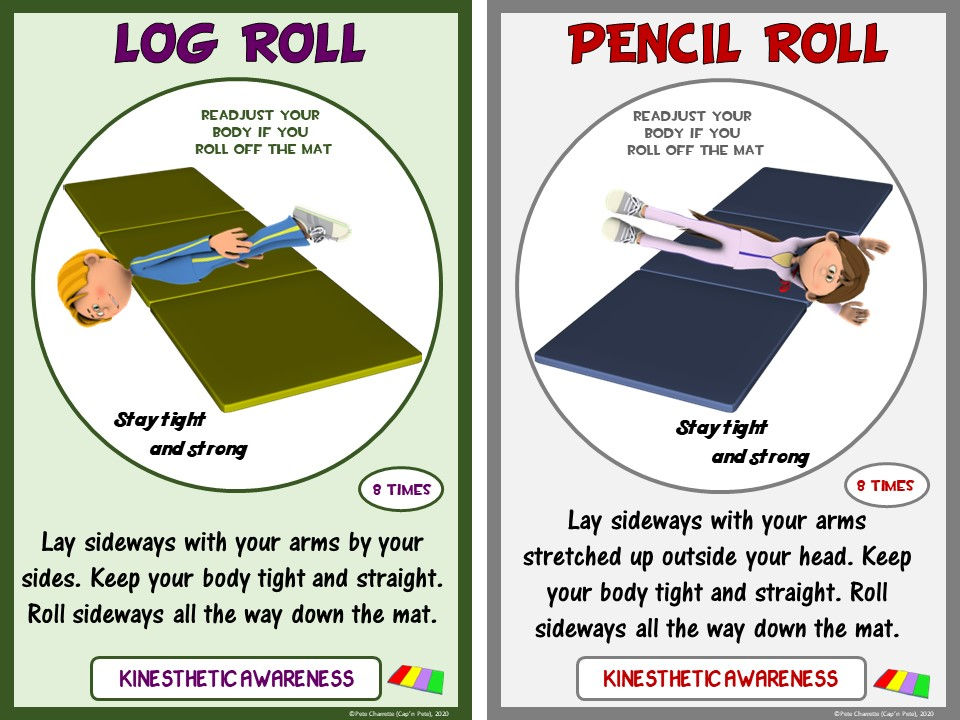
Pencil Roll: Lay sideways with your arms stretched up outside your head. Keep your body tight and straight. Roll sideways all the way down the mat
Egg Roll: Lay sideways and grab your knees with your hands and pull your self into a tight ball. Stay in a ball and roll sideways down the mat.

Forward Roll: Start in squat with your hands out front. Push with your legs and place your hands down on the mat. Roll on the back part of your head and stay in a tight ball.
Tripod: Get in a squat position. Put your head & hands down on the mat forming a triangle shape. Bring your knees (right leg then left leg) to your elbows and balance on your forehead and hands.

Headstand: Begin the balance with a 3-point tripod (triangle shape). From the tripod, slowly lift your legs up into the air. Keep your body straight and tight.
10 Lesson Activities to Incorporate Balance and Kinesthetic Awareness in a Lesson
Fitness circuits - balance style.
Fitness Circuits, in the context of balance and kinesthetic awareness, are structured yet dynamic series of “mini stations” where students immerse themselves in targeted exercises. These stations are thoughtfully placed throughout a gym, field, or classroom, and each station is uniquely crafted to challenge and develop balance and spatial awareness.
Spanning from a brisk 30 seconds to an invigorating 2 minutes, the duration of each circuit is adjusted to suit the age and endurance of the students, ensuring they are challenged without feeling overwhelmed. These exercises may range from one-legged stands on balance boards, blindfolded object navigation, to animal walks or jumps/rolls on a mat.
When balance and kinesthetic-focused exercises are integrated into the circuit routine, students not only develop core strength and stability but also a heightened sense of their bodies in space. This approach is instrumental in cultivating grace in movement, improving posture, and enhancing overall motor coordination. Furthermore, such circuits offer variety, ensuring that students remain engaged and intrigued, thereby maximizing the potential for consistent and sustained improvement.
Obstacle Courses
Obstacle courses offer an exciting and practical way for students to better understand balance and body movement. Incorporating elements such as balance beams, unstable surfaces, and climbing structures can stimulate students' motor skills, challenging them to maintain stability while maneuvering through various physical obstacles. These challenges encourage students to maintain their balance while moving in different ways, providing more than just a test of strength, but a true lesson in controlling their bodies under varying conditions.

The real beauty of obstacle courses is that they make learning a fun and enjoyable experience. As students navigate through different obstacles, they get to physically experience and understand how their bodies respond to different challenges. This hands-on experience helps them quickly make decisions, adapt their movement according to the situation, and stay balanced on a range of surfaces. As they tackle each challenge, they're not just becoming more physically adept, they're gaining confidence in their abilities. This confidence, combined with a better understanding of their bodies, benefits them in sports and other physical activities, ensuring that they learn while having fun.
Yoga and Pilates
Yoga and Pilates are more than just typical workouts; they're about truly connecting with your body and moving deliberately. These practices require you to tune into your body, focusing on balance, strength, and understanding each movement deeply. By doing so, participants develop a keen sense of how their body operates, which is crucial for improving one's awareness of body movements and positioning in space.

What's great about Yoga and Pilates is their flexibility to cater to all levels. Beginners can begin with basic poses and exercises, ensuring a solid foundation is set. These simpler routines introduce essential concepts of balance and body awareness. As one advances, the routines can become more intricate, offering increased challenges. This progression allows participants to continuously challenge themselves, ensuring growth and a deepened connection with their body. Whether someone is new to the practice or has years of experience, Yoga and Pilates offer endless opportunities for learning and enhancing body awareness.
Climbing Activities (Climbing Walls and Ropes)
Climbing, whether it's on a wall or a rope, is a great way for people to get a feel for their bodies and learn how to maintain balance. Every move a climber makes requires careful thought - where to put their hands, where to place their feet, how to shift their weight. These decisions need to be made quickly and correctly to prevent falls, teaching the climber to understand their body's movements and reactions better.

What's even better is that this kind of activity is exciting and enjoyable for students. It's not just a physical challenge, but a fun game that keeps them engaged and interested. As they overcome the obstacles in their path and reach new heights, they're not just building muscle and endurance. They're also learning valuable lessons about balance and body movement. This combination of fun and physical learning ensures that students stay interested and invested in their education, making climbing a highly effective way to teach these important skills.
Gymnastics and Tumbling Movement Experiences
Tumbling and gymnastics, even at basic levels, are fundamental to developing balance and kinesthetic awareness. Simple exercises, from 1 and 2 foot jumps to forward and backward rolls, instill in students a keen awareness of their body's position. These activities, while challenging, introduce learners to the intricacies of motion, strength, and spatial orientation, creating a strong foundation for mastering complex movements.
Advancing to inverts like tripods, headstands, cartwheels, and handstands, students are immersed deeper into the art of body control. Such movements demand precise weight distribution, alignment, and continuous adjustments. While appearing effortless when mastered, these exercises necessitate a profound understanding of body mechanics. They not only enhance balance and spatial perception but also help students appreciate the capabilities and complexities of their own bodies.
Balance Stations Using PE Equipment

Balance and Kinesthetic Awareness Stations, incorporating various physical education equipment, provide students with diverse and engaging ways to develop balance and body awareness. For instance, balance boards allow students to understand weight distribution as they focus on maintaining stability. Stability balls add another level of challenge, requiring
students to engage several muscles as they perform a series of movements without losing their balance, thereby sharpening their kinesthetic awareness.
Introducing elements of fun, hula hoops can be used to improve rhythmic coordination and body awareness, as students try to keep them in continuous motion. Agility ladders, usually associated with speed and agility training, serve to improve balance and coordination when students execute different footwork patterns swiftly. Another exciting piece of equipment is the BOSU ball, known for its unique half-dome shape. Performing exercises on these unstable surfaces requires a heightened sense of body positioning and control, thereby enhancing balance and body awareness.

Jump ropes can also be added to these stations. While often seen as a cardiovascular exercise, jump roping requires coordination between hand movements and jumps, promoting balance and rhythm. Incorporating these diverse pieces of equipment not only introduces a variety of physical challenges that improve balance and body awareness but also maintains student engagement.
Blindfolded Activities
Blindfolded activities provide a unique twist in developing balance and kinesthetic awareness among students. The concept behind these activities is simple but powerful: by temporarily removing one's ability to see, reliance on other senses, particularly the sense of balance and awareness of body in space, is enhanced. When sight, which is often our primary source of information, is taken out of the equation, the body is forced to adapt, relying on other senses and internal cues to navigate and move.

Consider simple activities such as walking in a straight line, performing a hop backwards or catching a ball. Typically, these tasks might seem quite easy, but when performed blindfolded, they become notably more challenging. For instance, navigating through a simple maze blindfolded demands a heightened sense of body awareness, as students must use their internal sense of direction and distance to move around. These activities not only help students develop better balance and body awareness, but they also cultivate trust in their abilities and enhance their adaptive skills when faced with unexpected challenges.
Juggling is not only a fun and entertaining activity but also an excellent method for enhancing hand-eye coordination, timing, and spatial awareness, which are all crucial components of balance and kinesthetic awareness. Starting with simple scarves allows beginners to grasp the basic juggling patterns without feeling overwhelmed. As they
progress to juggling balls or bean bags, the complexity increases, challenging students to refine their hand-eye coordination and timing. The act of juggling demands precise control over movements, as students must accurately toss and catch the objects in a continuous rhythm.

Moreover, juggling requires students to be acutely aware of the spatial relationship between their hands and the objects they're juggling. This heightened spatial awareness plays a significant role in developing balance and kinesthetic awareness. As students practice, they become more attuned to the positioning of their hands in relation to the flying objects, learning to make small adjustments to maintain control and keep the juggling pattern going.
Incorporating dance in physical education classes is a powerful way to enhance balance and kinesthetic awareness. Dance routines require students to be attuned to their body's positioning, weight distribution, and coordination, fostering improved balance. The intricate footwork and graceful transitions demand a heightened sense of control, contributing to enhanced body awareness.

Furthermore, dance emphasizes the connection between mind and body, fostering a deeper understanding of physical abilities and how to utilize them effectively. Working in sync with others in a group also develops spatial awareness and adaptability. Overall, dance offers a holistic approach to improving balance and kinesthetic awareness, empowering students to become more confident, coordinated, and in tune with their bodies.
Partner Balance Activities
Partner balance activities are a wonderful addition
to physical education classes as they not

only strengthen individual balance but also foster teamwork and communication. Students engage in exercises that involve maintaining balance while in contact with a partner. This could include standing on one leg while holding hands or attempting back-to-back squats together. These activities encourage students to synchronize their movements, coordinating their efforts to stay balanced and support each other.

Through partner balance exercises, students learn to rely on each other for stability, requiring effective communication and cooperation. They develop trust in their partners as they work together to achieve a common goal. Additionally, these activities promote a deeper understanding of balance, as students must adapt their movements according to their partner's actions and body positioning. The social aspect of partner balance activities makes them not only beneficial for physical development but also valuable for building camaraderie and fostering a positive learning environment
Final Thoughts
In summary, balance and kinesthetic awareness are vital elements in physical education, underpinning physical competence and fostering a strong mind-body connection. Beyond strength and speed, these skills contribute to overall well-being and play a pivotal role in sports performance, injury prevention, and cognitive development. Incorporating balance and kinesthetic awareness in PE not only enhances physical performance but also fosters engagement, teamwork, and confidence. Physical education is a holistic approach that nurtures students' physical, emotional, and mental health, making balance and kinesthetic awareness invaluable life skills.

Incorporating balance and kinesthetic awareness in PE classes offers numerous benefits, including improved sports performance, better coordination, injury prevention, increased confidence, and the promotion of an active lifestyle. Teachers can implement various strategies such as fitness circuits, gymnastics, obstacle courses, yoga, and partner activities to engage students in enhancing these essential skills. By embracing the significance of balance and kinesthetic awareness, educators empower their students to lead healthier, more competent lives, appreciating the profound connection between their minds and bodies.
Need resources?
Do you need some PE Component of Fitness Task Cards for your physical education program that includes detailed instructions and state-of-the-art graphics and visuals? If you do, Cap'n Pete's Power PE has you covered!

Fill in the form below to download 20 FREE Component of Fitness Task Cards. The set is a PDF digital download that includes two visuals (cards/signs) from the following sport stations sets: 1. Cardiovascular Endurance, 2. Flexibility, 3. Muscular Endurance, 4. Muscular Strength, 5. Agility, 6. Balance, 7. Coordination, 8. Power, 9. Reaction Time and 10. Speed.
They are simple to use and effective for learning PE fitness movements. Just print laminate, cut out and then place them in sections of your learning area for your students to use during physical education lessons.
If you're searching for a way to take your PE program to the next level, Cap'n Pete's PE Components of Fitness Task Card Series- 10 Set SUPER BUNDLE is the perfect resource for you! It is a combination of 10 of Cap’n Pete’s DYNAMIC, health-related and skill-related fitness-based task card sets for students to use in a variety of educational or community settings. You'll find over 240 engaging, self-guided fitness-based movement station signs/cards (24 stations per component) in this super bundle.

You can download them from either of the following platforms: Cap'n Pete's Power PE Website or Teachers Pay Teachers- Cap'n Pete's TPT Store

- Fitness Activities
- Stations and Circuits
Related Posts
18 Top PE Activities for Dynamic Physical Education Classes
Run, Walk, Thrive: How to Implement a Mileage Club at Your School
Energizing Education: The Power of Brain Breaks in the Classroom; Includes 12 Practical Activities
Comentarios
Recent Posts

Physical Education and Childhood Obesity: Empowering a Healthier Generation

Understanding the New SHAPE America Physical Education Standards for 2024

Mastering the Dynamics of PE Classroom Management: A Comprehensive Guide

PE Games for Elementary Students: 6 Dynamic Physical Education Games to Transform Your Classes

Physical Education Advocacy Amplified: Elevating Your Voice

Engaging At-Home PE Activities for Effective Distance Learning in Physical Education

Adopt-a-Gym: Enhancing Physical Education for Underfunded Schools

Best Physical Education Equipment Providers 2024: Your Complete Resource

PE Stations: 15 Fun Ideas for Active Engagement in Elementary Physical Education Classes

Exploring the Role of AI in Physical Education: Enhancing Efficiency and Effectiveness in Teaching PE

Cultivating Positive Character Traits for Students in Physical Education: Shaping Tomorrow's Leaders

What is Physical Education? A Comprehensive Overview for Physical Educators
We use cookies to give you a better website experience. By using Dynamic PE ASAP website, you agree to our Privacy Policy.
Get to Know the Activity Card
Every activity from the Dynamic PE lesson plans can be seen here. You can see below the different elements that make up an activity card. You can sort by each of these elements, making it easy to find the exact activity you are looking for.
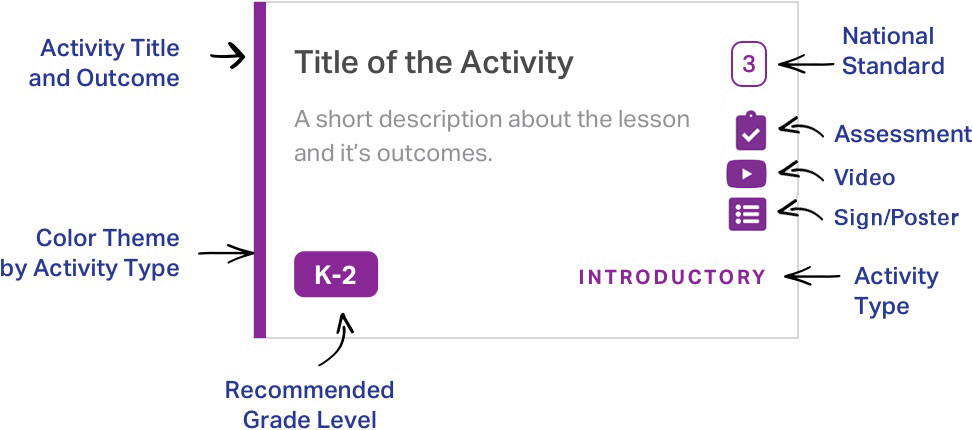

Lesson Plan Sections
- Environmental (1)
- Science (1)
P.E. Lessons
Physical education prepares children for an active and healthy life while improving self discipline and reducing stress. This section includes PE lessons from kindergarten through high school spanning different skill levels and objectives. Lessons are categorized by grade for easy retrieval. These lessons were created by real teachers working in schools across the United States. The section will continue to grow as more teachers like you share your lesson plans. We encourage you! Share your lessons plans Teacher.org, contact us .
Sponsored School(s)
P.e. environmental lesson plans, food chain tag.
Students will learn a brief background about energy transfer between the sun, producers, primary consumers, and secondary consumers. ½ of the students are primary consumers (plants) and ¼ of the students are primary consumers (rabbits) and ¼ of the students are secondary consumers (hawks).
P.E. P.E. Lesson Plans
Aces and exercise.
Using a deck of playing cards, the students will pick the number of reps for various exercises.
And Freeze!
Students will practice listening skills and basic physical concepts as required in physical education class. Students will also work on balance and coordination.
Animal Laps
Combining information about the speed of animals, the students will run laps in the gym or outdoors.
Basketball Relay
Students will practice teamwork, dribbling, and shooting a basketball.
Bear Hunt Obstacle Course
This plan will combine reading with balance and coordination skills to allow students to navigate a simple obstacle course.
Boom Over Movement Game
Students will play a game in which they need to change direction quickly. Students are to pretend that they are on a sailboat that is in the middle of a storm. They will have to run and change direction based on verbal commands and duck quickly to avoid being hit by the imaginary boom.
Butterfly Stretches
This lesson is designed to help students learn the importance and reasons for exercise through multiple activities and discussions.
Coordination Course
This plan will allow students to practice coordination while staying physical.
Multi-Ball Basketball
The student will participate in a game of basketball using various sizes of available balls.
Music Movement
The students will move to the music based on its beat, words, tune, and other variables.
On Top of Spaghetti
Pe immigration.
The students will research games and activities from other countries to share during a PE class.
Pass It Off
This lesson will allow students to practice passing, dribbling, and bouncing skills using basketballs
Plate Aerobics
Students will practice basic aerobics moves while trying to stay positioned on paper plates, this aids in coordination.
Race to the Answer
This lesson will allow students to practice teamwork, basic math skills, and get exercise through a relay race. Note: Problems/difficulty level can be altered by grade
Ride ‘Em Cowboy/girl
This lesson will allow students to practice gross motor skills.
Students will practice listening skills and basic physical concepts as required in physical education class.
Ski to the Finish Line
This plan will allow students to practice coordination while staying physical. Students will demonstrate moving straight, backwards, and in a zig-zag pattern.
The New PE Class
The students will create a PE activity to share and demonstrate to peers.
This lesson will allow students to practice teamwork and trust building, as well as working on directionality for younger students.
What Time is it FOX?
The students play a game where they practice different movements including jumping, galloping, skipping, running, jogging, leaping, and walking. Based on National Physical Education Standards, students should have been learning these skills for the last 4 years.
P.E. Science Lesson Plans
Ready to pursue a master’s degree in education make it your time.
Teacher.org’s lesson plans encourage conceptual understanding and lifelong learning skills in students as well as empower and motivate teachers.
Are you currently teaching but have the desire to pursue a Master’s Degree in Education? Follow your passion for teaching but at the same time give yourself the tools to further your career and learning. Whether it’s higher salaries, advanced career opportunities, or leadership positions, earning your Master’s Degree in Education is one worth pursuing. Make it your time!
- Games to Play with Friends
- Indoor Group Games and Activities
- Fun Outdoor Games for Kids
- Fun Frisbee Games for Kids
- Trivia Questions for Kids
- Fun Playground Games for Kids
- Preschool Themes
- St. Patrick’s Day
- Valentine’s day
- Thanksgiving
- 75 Clean Jokes for Kids to Tell at School
- 55 Funny Halloween Jokes for Kids
- 45 Cow Jokes for Kids that Adults Will Love Too
- 101 Winter Jokes for Kids
- Our Editorial Guidelines
- Meet Our Review Board
- Weekly Column
Themes & Lesson Planning
25 elementary physical education lesson plans.
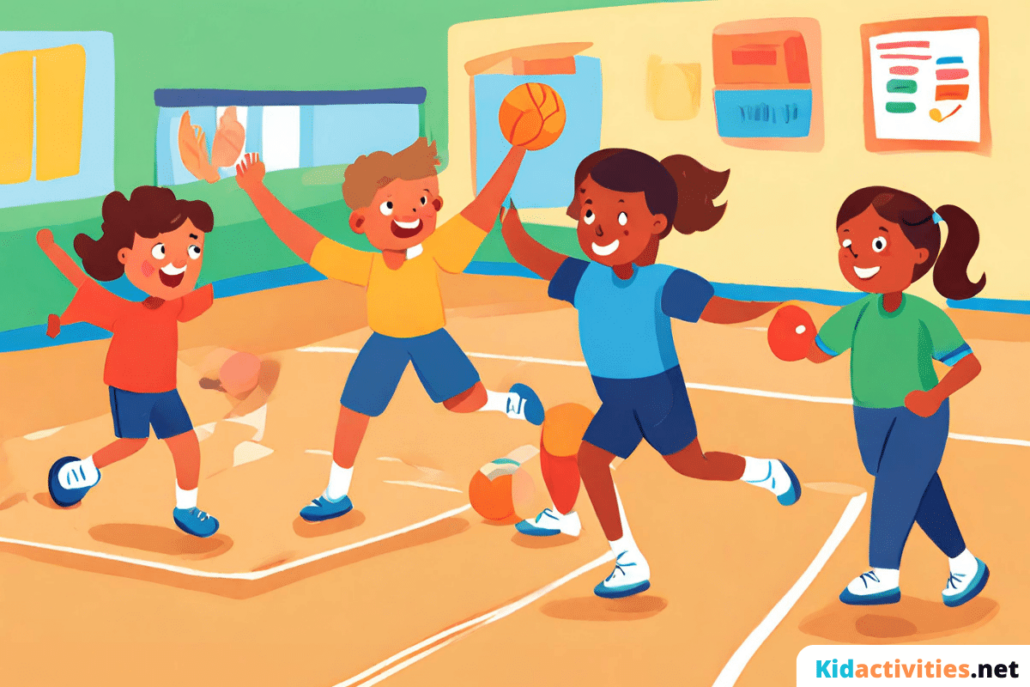
Almost every elementary school curriculum includes physical education. Physical activity should be a regular part of children’s lives so they can develop their activity skills, motion, balance and overall physical fitness.
Physical activity not only helps children develop critical physical skills, but it also encourages healthy habits and improves educational performance .
To ensure that students receive a comprehensive physical education experience, it is important to have well-planned and engaging lesson plans . However, even experienced teachers find it challenging to design engaging and developmentally appropriate physical education lesson plans.
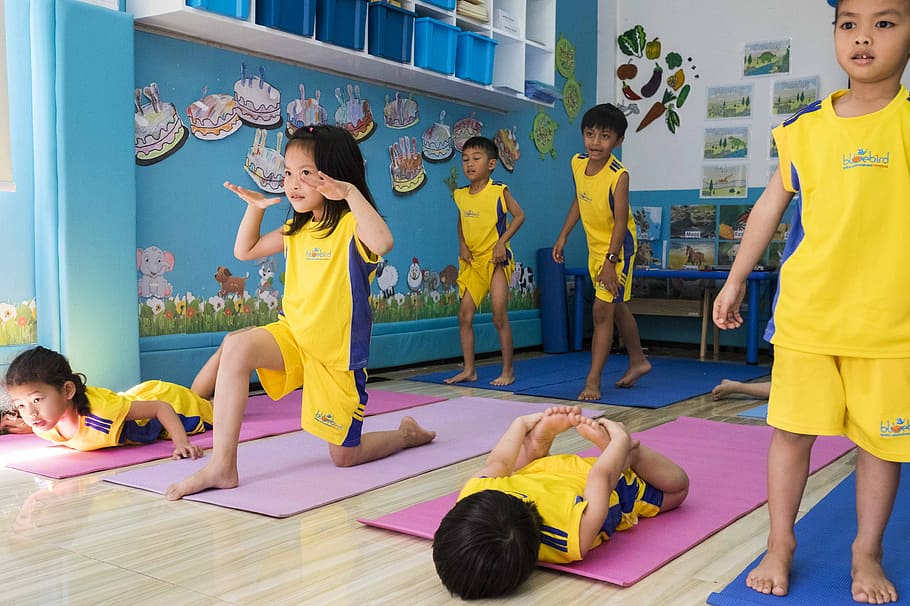
Fortunately, there are many resources available for teachers to create effective physical education lesson plans. A little creativity and planning can help teachers design lesson plans that incorporate a variety of skills and activities, and tailor them to their students’ skills and needs.
The goal of this article is to explore the fundamentals of physical education lesson planning for elementary students. Our goal is to provide an overview of the different types of lessons that can be used to engage students and develop appropriate fitness goals and objectives.
Whether you are a new teacher looking for inspiration or an experienced teacher updating your curriculum, this article will provide you with information and ideas that will make creating engaging and effective physical education lesson plans easier.
You will gain insights into how to integrate different types of activities into your lessons, from warm-ups to cool-downs. In general, this article will help you plan effective physical education lesson plans that will improve the physical skills of your students and improve their overall health and well-being.
Why Physical Education Is Important for Elementary Students?
There are several reasons why elementary students need physical education lesson plans. The first and foremost purpose of physical education is to promote physical health and fitness .
Children can maintain a healthy weight, develop strong bones and muscles, and reduce their risk of chronic diseases like diabetes, heart disease, and obesity by participating in regular physical activity.
Including physical education in the school day ensures that children get the exercise they require in order to stay healthy.
Besides promoting physical health , physical education lesson plans encourage children to develop motor skills and coordination . Practicing coordination and balance while running, jumping, throwing, and catching can help children develop a greater sense of body awareness and control.
Physical activity is also linked with mental development and consistency that’s why developing athletic skills at a young age can also help children perform better academically.
Social and emotional development is another skill that can be promoted through physical education lesson plans . Communication, cooperation, and teamwork are among the social skills that children can develop through group activities and team sports.
During these activities, children can gain new skills, achieve personal goals and build self-esteem and confidence.
It’s a common fact that fun and engaging physical education lesson plans can keep students motivated and active throughout the school day.
Let alone that teaching children how to remain engaged in physical activity can help them develop healthy habits that will last a lifetime.

List of Elementary P.E Activities for your Lesson Plan
1. warm-up stretches.
Warm-up stretches are an essential feature of any physical education lesson plan . The benefits of stretching before physical activity include preparing the body for movement, increasing blood flow to the muscles, and reducing the risk of injury . Warming up your students with stretches can also keep them engaged and motivated.
Your warm-up routine can be enhanced by teaching students different stretches and having them perform them in a circuit-style fashion . During a circuit-style warm-up, students rotate through different stretches or exercises, each performing the stretch or exercise for a set amount of time before moving on to the next.
Make sure your warm-up stretches target a variety of muscle groups and body parts . For example, you might do stretches for the hamstrings, quadriceps, calves, chest, shoulders, and neck. However, keep in mind that students should also be taught stretches that are appropriate to their age and skill level.
To make warm-up stretches more engaging add music to your warm-up stretches or incorporate partner stretches . Stretching with a partner can improve trust and teamwork skills for students, as well as provide a deeper stretch than stretching alone.
Stretching is a great way to prepare your students’ bodies for physical activity while also keeping them active and enthusiastic. Lastly, by teaching students the importance of warming up and stretching before any physical activity, you can help them develop healthy habits that they can carry into their future.
2. Fitness Circuit
Incorporating a fitness circuit into a physical education lesson plan is a great way to include a variety of exercises and activities . The intention of a circuit is to rotate through several stations, each focused on a different type of activity or exercise.
Here is an example of a fitness circuit for elementary students:
Station 1: Jumping Jacks
Students should perform 20 jumping jacks. By performing this exercise, students will improve cardiovascular endurance and strengthen their arms, legs, and core.
Station 2: Hula Hoops
Give students hula hoops and have them practice spinning them around their waists or performing tricks with them. This activity helps develop coordination and balance.
Station 3: Lunges
On each leg, have students perform 10 lunges. By performing this exercise, students will strengthen their legs and improve their balance.
Station 4: Jump Rope
Give students jump ropes and have them jump continuously for 30 seconds. This exercise boosts cardiovascular endurance and coordination.
Station 5: Push-ups
Have students perform 5 push-ups. This exercise is ideal for building up the upper body.
Station 6: Balance Beam
Set up a balance beam and have students practice walking across it or doing other balance exercises. This activity can improve balance and core strength.
Station 7: Sit-ups
Students should perform 10 sit-ups. This exercise helps strengthen the core.
Rotating through these stations will not only improve students’ coordination, balance, and cardiovascular endurance, but will also offer a full-body workou t.
By increasing the number of repetitions or the amount of time spent at each station, you can make the circuit more challenging. If you feel that your circuit lesson plan becomes a bit boring you can switch out stations or use different equipment.
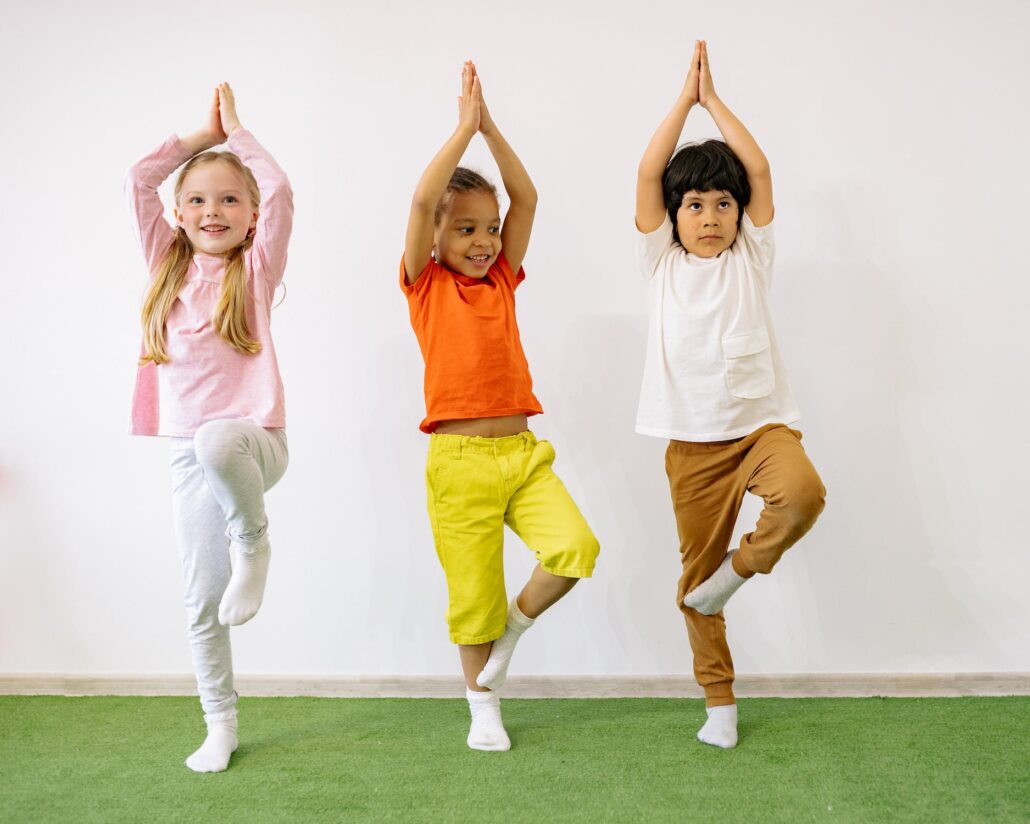
Yoga poses can be a fun and engaging way to promote physical activity and mindfulness in elementary school students. It has been proven that yoga is beneficial to both mental and physical health , including increasing flexibility, strength, and balance, and reducing stress . Here is an example of a basic yoga sequence that can be used with elementary school students:
- Mountain Pose
Students should stand tall with their feet hip-width apart and their arms by their sides. Encourage them to take deep breaths and focus on grounding themselves in the present moment.
- Downward Facing Dog
In the downward-facing dog pose, students should come down on their hands and knees, then lift their hips up and back. Practising this pose is beneficial for stretching the hamstrings, calves, and spine.
Bring students into standing and have them rest one foot on the opposite thigh, pressing their foot into the thigh while bringing their hands to their heart centre. The purpose of this pose is to improve balance and concentration.
- Child’s Pose
Get students to come down to their knees and sit back on their heels, stretching out their arms. Practising this pose helps to release tension from the back and shoulders.
By introducing students to basic yoga poses and guiding them through a sequence, you can help them foster physical skills, mindfulness, and overall well-being . Let alone group yoga can also foster a sense of community and connection among students.
4. Tag Games
The c lassic and popular tag game is a great way to get elementary school students active. Chasing after and trying to tag their peers is an excellent way to promote cardiovascular endurance and coordination . The following are some examples of classic tag games that can be played with elementary school students:
During freeze tag, one player is “it” and tries to tag other players. When tagged, a player must freeze in place until another player crawls between their legs to “unfreeze” them. The game continues until all players are frozen.
- Sharks and Minnows
In Sharks and Minnows, one or more players are designated as the “sharks” and sit in the centre of a selected area. The other players are the “minnows” and must try to run from one side of the area to the other without getting tagged by the sharks. In the event that a player is tagged, they become a shark and help on tagging other players.
In blob tag, one player starts as the “blob” and tries to tag other players. A tagged player must help tag other players by joining hands with the blob. As more players join, the blob grows bigger and bigger until every player has been tagged.
Elementary school students can have fun while improving their cardiovascular endurance, coordination, and teamwork skills when they play tag games. It is also possible to modify or change the rules of these games in order to make them suitable for different skill levels and group sizes.
Additionally, playing tag games can promote physical activity and exercise while also developing social skills like communication and sportsmanship.
5. Ninja Warrior Course
The Ninja Warrior Course is a challenging and exciting way to encourage physical activity and develop strength, agility, and problem-solving skills in young students.
The Ninja Warrior course is based on the popular television show American Ninja Warrior and can be set up indoors or outdoors, depending on the skill level and size of the group.
Some popular obstacles in a Ninja Warrior Course for kids involve balance beams, rope swings, cargo nets, monkey bars, and wall climbs. By setting up a Ninja Warrior course kids can build their confidence and skills gradually as they progress through the obstacles.
Elementary school students benefit physically and mentally from Ninja Warrior Courses. It is a great way to promote fitness and healthy habits, while also encouraging kids to challenge themselves and develop important life skills .
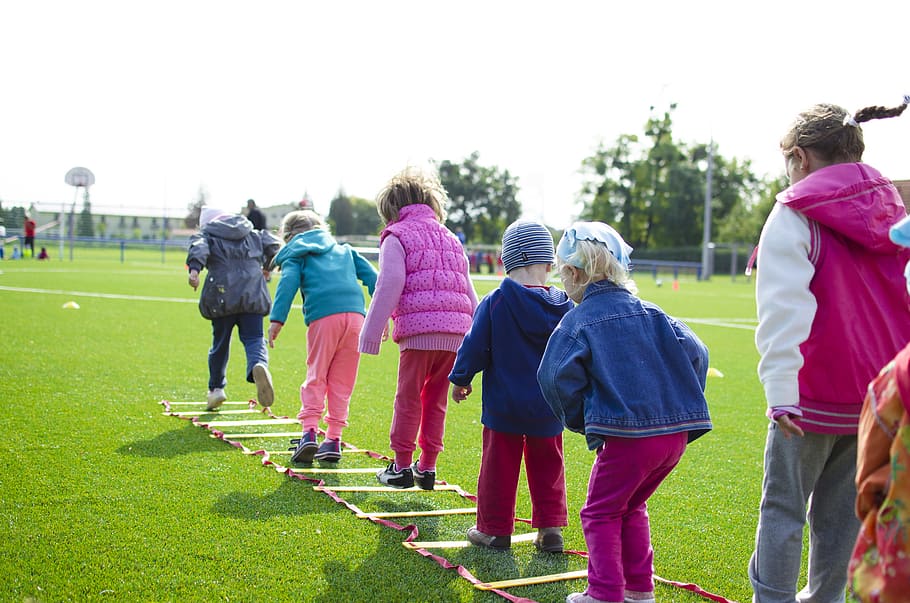
6. Football Skills
Football is one of the most favourite and adored sports of all time. Kids love to play and chase the ball; that’s why creating a P.E. lesson plan for football will excite students.
Football skills r efer to the physical abilities and techniques required to play football effectively . These skills include passing, dribbling, shooting, and ball control , among others. Developing football skills requires practice, coordination, and physical fitness.
By improving their football skills, students can increase their enjoyment of the game and improve their performance on the field . Additionally, learning football skills can encourage physical exercise and healthy routines, while also building trust and teamwork skills.
Football Skills Lesson Plan Example
Materials: Footballs, cones or markers, goals or target areas.
Warm-up (5-10 minutes):
- Jogging: Have students jog around the field or designated area to get their heart rate up and warm up their muscles.
- High Knees: Have students jog in place while bringing their knees up to their chest.
- Butt Kicks: Have students jog in place while bringing their heels up to their butt.
- Side Shuffles: Have students shuffle to the left and then to the right, facing the same direction.
- Stretching: Have students stretch their legs, arms, and back.
Main Activity (30-40 minutes):
- Passing Drills: Divide students into pairs and have them practice passing the ball back and forth to each other. Encourage them to use the inside of their foot to pass the ball accurately.
- Dribbling Drills: Set up a course using cones or markers and have students dribble the ball through the course, using both feet to improve their coordination and control.
- Shooting Drills: Set up goals or target areas and have students practice shooting the ball into them. Urge them to use proper techniques, such as planting their non-kicking foot next to the ball and following through with their kicking foot.
Cool Down (5-10 minutes):
- Walking: Have students walk around the field or designated area to bring their heart rates back down.
- Static Stretching: Have students stretch their legs, arms, and back to prevent muscle soreness and improve flexibility.
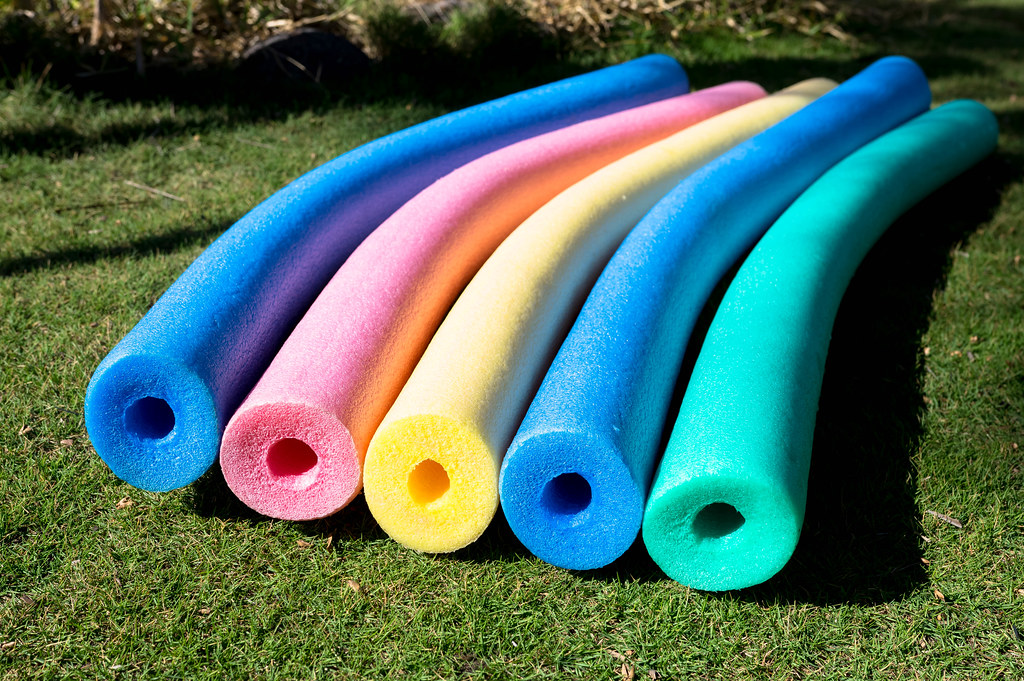
7. Noodle Hockey
The game of noodle hockey is a great way to expose children to hockey and help them build their physical fitness and agility. The soft and less rigid nature of pool noodles makes the game safer and less likely to cause injury; that’s why they are excellent for an elementary physical education activity.
In addition, the use of foam balls as the puck allows for a lighter and easier-to-handle object, making it accessible for young children to participate.
Including noodle hockey in elementary physical education courses or after-school activities can encourage communication and teamwork . The game provides children of all skill levels with a fun and inclusive environment for them to enjoy and develop a love of physical activity.
Noodle hockey is an excellent way to introduce children to the fundamentals of a popular sport while teaching them about staying active.
8. Balloon Tennis
Another enjoyable activity for physical education classes in elementary school is balloon tennis. Regardless of the season, physical education teachers can easily set up the game, use minimal equipment, and play it indoors or outdoors.
During balloon tennis, children can exercise and develop their motor skills, coordination, and reflexes while having fun . This low-risk activity uses a balloon instead of a ball, so children can learn the basics of tennis without being injured or frustrated by the traditional tennis ball and racket.
Furthermore, balloon tennis can be played in groups or pairs , allowing children to develop communication and teamwork skills. It is also possible to modify the game rules so that it is accessible to students of all skill levels.
In general, balloon tennis is a safe and fun way to teach children the fundamentals of popular tennis sport.
9. Fitness Dice
Fitness dice is a fun and interactive way to encourage physical activity in elementary schools. These large foam dice have different exercises and movements printed on each side , such as jumping jacks, lunges, and push-ups. S tudents roll the dice and then perform the exercise indicated on the side that faces up.
Fitness dice can be used in a variety of ways in elementary physical education classes. Teachers can use them as part of a warm-up routine or as a way to break up the monotony of traditional exercises. They can also be used in group activities or as a fun way to introduce new exercises and movements to students.
Using fitness dice in elementary schools encourages physical fitness and helps children formulate coordination, balance, and dexterity. Additionally, because the dice provide a variety of exercises, students can exercise different muscle groups and improve their overall fitness levels.
Fitness dice are also a great way to make physical activity more fun and engaging for children . They can be used as part of a game or challenge, and students can compete with one another to see who can complete the exercises the fastest or with the most accuracy.
Overall, fitness dice is a versatile and useful tool for boosting physical training and improving fitness levels in elementary schools. The foam dice exercise can provide a fun and interactive way for children to engage in physical activity and develop important motor skills and coordination.
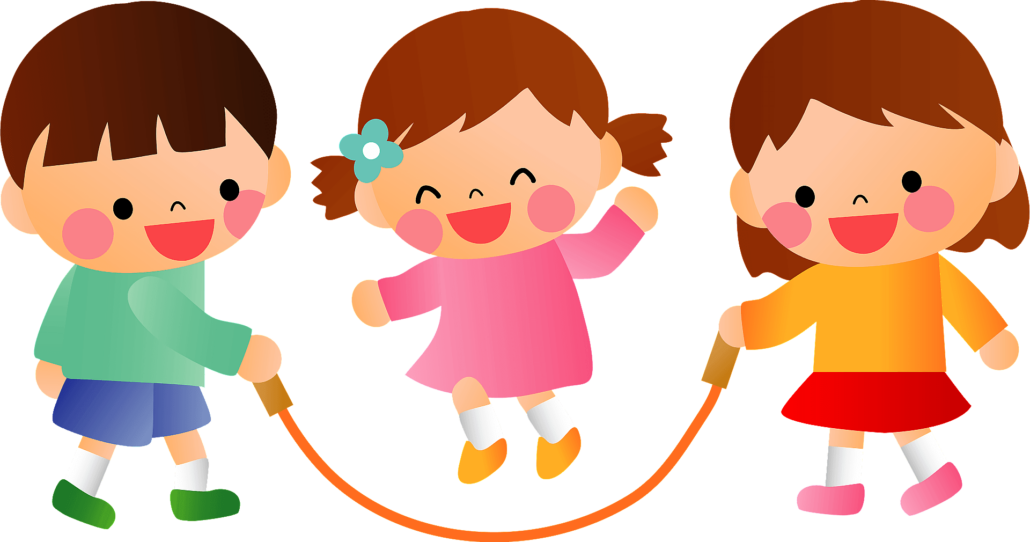
10. Jump Rope
Jump rope is a traditional and widely used physical exercise that can be integrated into elementary school physical education plans. Students can benefit physically and mentally by learning basic jump rope skills and practising in groups or individually.
The jump rope activity c an improve students’ coordination, balance, and cardiovascular fitness. By playing this game – activity students can also gain a better sense of rhythm, timing, and spatial awareness . A fun and engaging activity like jumping rope can also help students relieve stress and improve their mood.
To teach elementary students jump rope skills, you should start with basic jumps such as the two-foot jump and then progress to more advanced jumps like the cross-over and double-under . To make the activity more exciting and varied, teachers can include jump rope games, such as Double Dutch.
It’s a versatile activity for all weather conditions , as you can game both indoors and outdoors. Additionally, the jump rope can be easily modified to suit different skill levels and abilities , making it accessible to everyone.
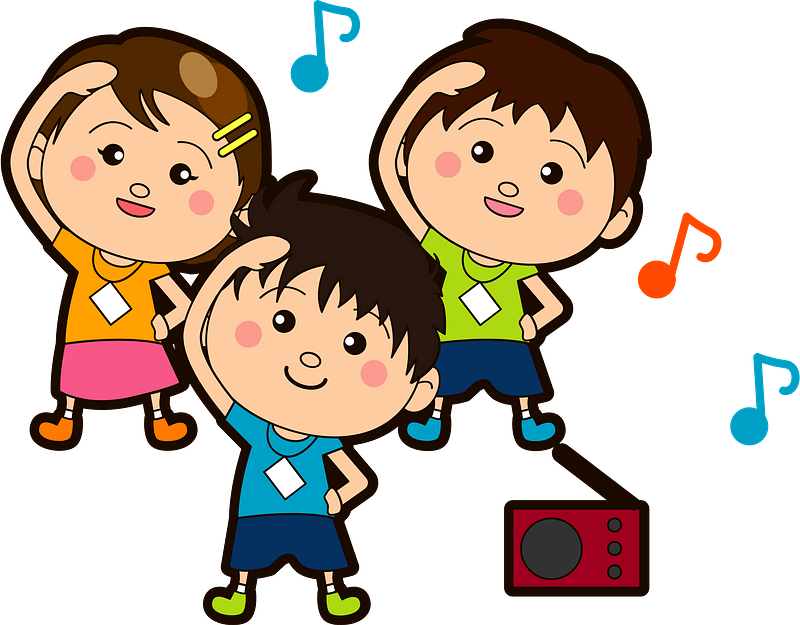
Including dance in an elementary school fitness education plan is an amazing way to inspire students to engage in physical activity while also delivering a fun and innovative source for self-expression. Introducing a simple dance routine and having students perform it together can offer a range of physical and mental benefits.
Dance delivers a full-body exercise that can improve cardiovascular fitness, strength, balance, and coordination . It can also improve flexibility, posture, and body awareness. Moreover, dance is an imaginative and expressive training that can assist students to build confidence, self-esteem, and social skills.
When teaching a dance routine to elementary students, it is important to choose music and choreography that are appropriate for their age. Teachers can also include different styles of dance, such as hip-hop, jazz, or ballet, to r eveal students’ different workout/dance techniques.
Dance can be performed both indoors and outdoors, making it an adaptable activity that can be adjusted to all spaces. It can also be altered to suit different group sizes, making it an inclusive activity for all students.
In summary, mixing dance into an elementary school physical education plan is an excellent way to encourage physical wellness, creativity, self-expression, and social skills .
By teaching a simple dance routine and encouraging students to perform it together, teachers can help students improve their physical and mental well-being while also having fun.
12. Heads or Tails
Heads or Tails is an exciting and easy physical exercise that can be used by elementary school physical education teachers to get students engaged and active during class time. All that is needed to play this game is a coin and a list of physical activities for students to perfor m.
To play Heads or Tails, pairs of students are given a coin and take turns flipping it. If the coin lands on heads, the first student in the pair chooses an activity from the list and the pair performs it together . If the coin lands on tails, the second student in the pair chooses an activity.
The list of physical activities can be tailored to the age and skill level of the students and can include a variety of exercises such as jumping jacks, push-ups, squats, or lunges . By allowing students to choose their own activities, they are more likely to be engaged and motivated to participate.
Heads or Tails is a great way to get students warmed up and ready for other fitness lessons . It is also a perfect activity for days when there is limited time for lesson prep. Additionally, this game helps to improve coordination, balance, and other physical skills.
Heads or Tails is a simple and practical physical activity that can be used by elementary school physical education teachers to engage students and get them moving.
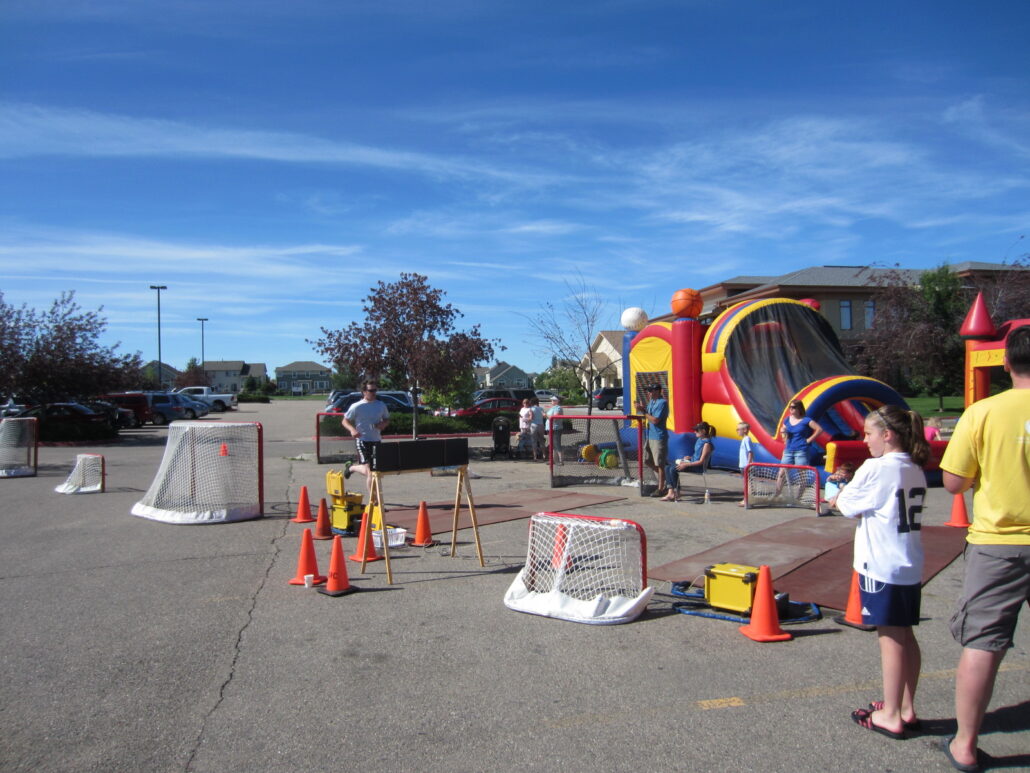
13. Cone Race
The cone race is a fun, engaging activity that is great for children in first grade and younger. By playing this game, students will improve their hand-eye coordination, motor skills, and colour recognition .
The activity involves placing cut-up pool noodles over tall plastic pipes or broom handles inserted into cones to hold them steady.
To play Cone Race, students are divided into teams and given a set of pool noodles that have been cut up into small pieces. The goal of the game is to match the coloured noodles with the corresponding cones . The team that matches all its noodles to the cones first wins.
For this fitness lesson, students must focus on their hand movements and the placement of the noodles as they place the cut-up pool noodles over the tall plastic pipes or broom handles.
A cone race is a great way to get young students moving and engaged in physical education. Regardless of class size or skill level, it is simple to set up and adaptable. Overall, the Cone Race is a great way to promote physical activity and help young children develop their motion and mental – thinking skills.
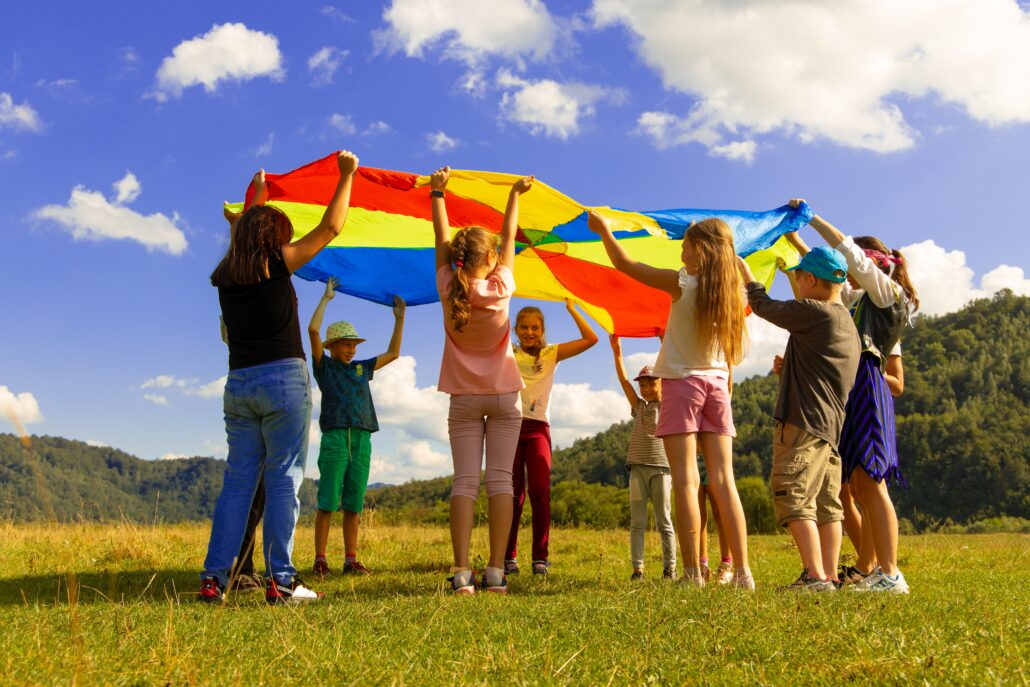
14. Parachute Fun
Parachute games are a fun and exciting way for elementary students to learn about teamwork, coordination, and motor skills . Here is a lesson plan for a parachute game that can be used in an elementary PE class:
Objectives:
- Students will learn to work together as a team.
- Students will develop gross motor skills.
- Students will have fun and stay active.
- Large parachute
- Balls or beanbags
- Warm-up: Have students stand in a circle around the parachute. Begin by keeping everyone hold onto the parachute with one hand and doing some light stretches with the other hand. Then, have them switch hands and repeat the stretches.
- Introduce the game: Present to the students that they will be playing a game with the parachute. Have them practice lifting and lowering the parachute as a group.
Game 1 : Ball toss. Place some balls or beanbags in the middle of the parachute. Have the students lift and lower the parachute to toss the balls into the air and then catch them on the parachute.
Game 2 : Parachute popcorn. Have the students lift and lower the parachute quickly to make the balls or beanbags “pop” up like popcorn.
Game 3 : Switch sides. Divide the students into two groups and have them stand on opposite sides of the parachute. On the count of three, have each group lift the parachute and walk towards the other group until they have switched sides.
- Cool down: Have the students gather around the parachute and take turns saying one thing they liked about the game.
Variations:
- Change the number of balls or beanbags used in the games.
- Change the movements of the parachute (e.g., waving, shaking, twisting).
- Add in more complex games like “shark attack” where students must run under the parachute without getting tagged by students holding it.
Parachute games are a great way to get students excited about PE while teaching them valuable skills like teamwork and coordination. By incorporating fun and interactive games like these into PE classes, students are more likely to develop a lifelong love of physical activity.
15. Olympic-Style Events
Olympic-style events can be a great way to engage elementary students in physical education and teach them about the importance of sportsmanship, cooperation, and determination .
These events can be created to be age-appropriate and can be adjusted to suit the skill levels and capabilities of each individual student.
Some examples of Olympic-style events that can be integrated into elementary physical education lesson plans include relay races, obstacle courses, long jump competitions, and mini-triathlons .
Students can be teamed into groups and allowed to contest against one another, with medals or ribbons awarded to the winners.
In addition to the physical benefits Olympic-style events, can also provide an opportunity for students to learn about different countries and cultures .
The Olympics is a global event that brings together athletes from all over the world, and elementary students can learn about different countries and their traditions through classroom discussion s and research projects.
Overall, Olympic-style events can be a joyful and fascinating way to encourage physical activity and teach important values to elementary students. By incorporating these events into physical education lesson plans, teachers can help students formulate a lifelong love of sports and physical fitness.
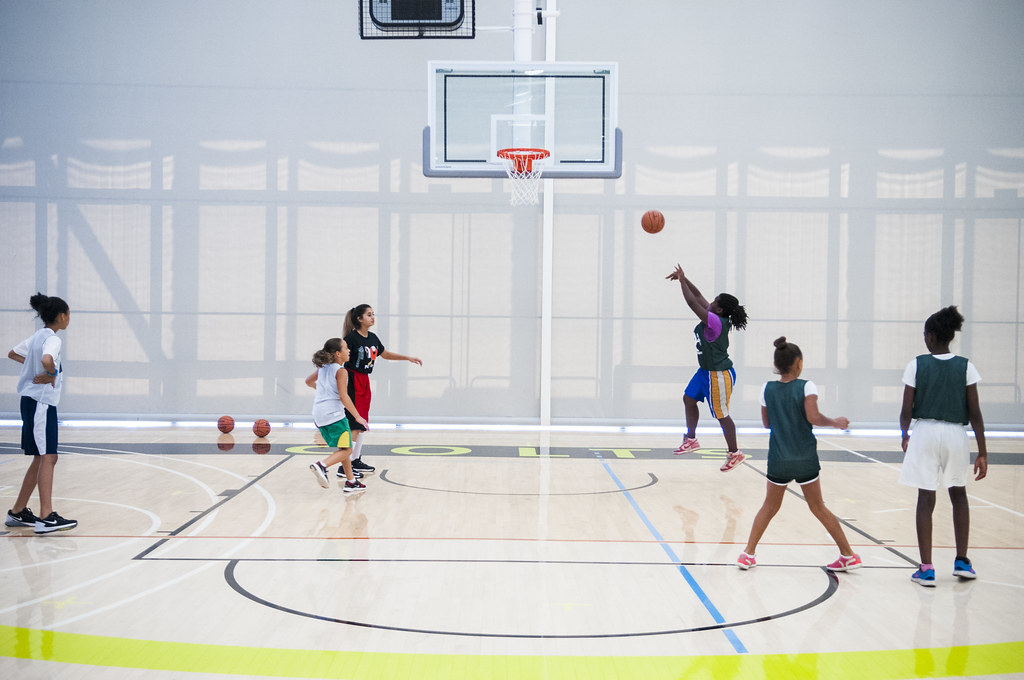
16. Basketball Skills
Basketball is a famous sport that can make students excited about physical education. Here are some basketball skills that can be integrated into an elementary physical education lesson plan:
- Dribbling : Familiarize students with the basics of dribbling, including proper hand placement and dribbling techniques. Have them practice dribbling in a specified area or through an obstacle course.
- Shooting : Introduce students to fundamental shooting techniques, such as the BEEF (balance, elbow, eyes, follow-through) approach. Have them practice shooting baskets from various spots on the court.
- Passing : Train students how to properly pass a basketball, including chest passes, bounce passes, and overhead passes. Have them practice passing to a partner or through an obstacle course.
- Defence : Teach students primary defensive techniques, such as guarding an opponent and blocking shots. Have them rehearse these techniques in one-on-one or small group drills.
- Gameplay : Separate learners into teams and have them play an altered game of basketball. Make sure to highlight the significance of good sportsmanship and teamwork.
By incorporating these basketball skills into a physical education lesson plan, elementary students can grow their coordination, teamwork, and sportsmanship skills, all while having fun and staying active.
17. Volleyball Skills
Volleyball is a famous team sport played worldwide, and it is also a great way to enhance physical wellness and develop teamwork skills. In elementary physical education classes, students can be introduced to the basics of volleyball and learn skills such as serving, bumping, setting, and spiking.
By incorporating volleyball skills into lesson plans, teachers can help students develop their hand-eye coordination, motor skills, and communication skills. Volleyball can be played with varying levels of intensity, making it adaptable for different age groups and skill levels.
- Students will be able to execute basic volleyball skills such as passing, setting, and serving.
- Students will be able to work collaboratively with their peers to accomplish a common goal.
- Students will learn the importance of communication and teamwork in a sports setting.
- Volleyballs
- Cones to mark boundaries
- Students will participate in a brief warm-up that includes jogging, jumping jacks, and stretches.
Skill Instruction
- The teacher will instruct students on how to perform basic volleyball skills such as passing, setting, and serving.
- Students will practice each skill individually, then work in pairs to practice passing and setting to each other.
- Students will divide into teams and play an altered version of volleyball that concentrates on practising the skills they learned.
- Teams will work to pass, set, and serve the ball over the net to score points.
- The teacher will observe and provide feedback to students to help them improve their skills.
- Students will participate in a brief cool-down that includes stretching and reflection on what they learned during the lesson.
Assessment:
- The teacher will assess students’ progress in performing basic volleyball skills during the gameplay portion of the lesson.
- The teacher will also assess students’ ability to work collaboratively with their peers and communicate effectively during the gameplay portion of the lesson.
- For advanced students, the teacher can introduce more complicated volleyball skills such as spiking and blocking.
- Students can make their own individual versions of the game to practice various skills.
- The teacher can include a discussion about sportsmanship and fairness in sports.
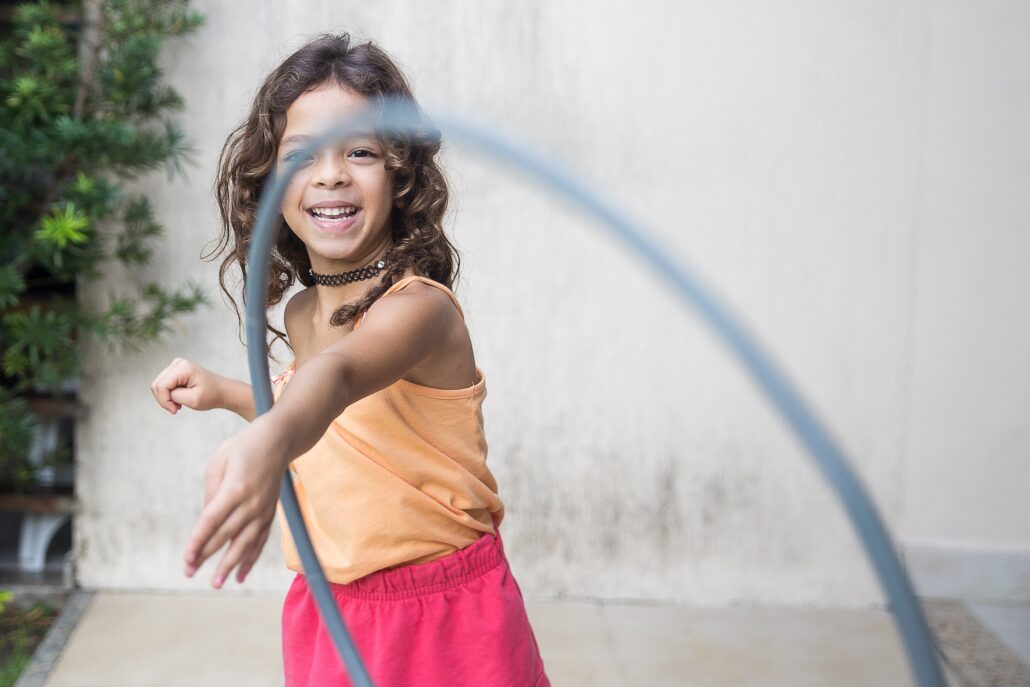
18. Hula Hoop
The Hula hoop is an adaptable object that can be utilised for a broad range of physical activities in elementary schools . It can help children develop their teamwork, balance, and motion skills , while also promoting cardiovascular health and endurance. In physical education classes, hula hoop games can be incorporated in many ways, including:
- Hula Hoop Relay
Divide students into teams and have them race to pass a Hula Hoop down the line as fast as possible. Each line of students stands in a line and holds a Hula Hoop. Upon receiving the signal, the first player passes the Hula Hoop to the next in line without letting go. The game continues until the last player in each line reaches the end and crosses the finish line.
- Hula Hoop Tag
This fun game twists the classic game of tag. To play the game Hula Hoops must be worn around students’ waists as they run around a designated area. The student who is “it” tries to tag the other students with their Hula Hoop. Students must also hold their own Hula Hoop once they are tagged and attempt to tag others.
- Hula Hoop Toss
An excellent game for developing hand-eye coordination. Each student tosses a Hula Hoop to a partner in a circle. A Hula Hoop must be kept moving around the circle without being dropped. If you want to make the game more challenging, try adding a second or third Hula Hoop.
- Hula Hoop Obstacle Course
Use Hula Hoops to create an obstacle course. In order to complete the game, the students finish the course without touching the Hula Hoops. This game is a great way to develop balance and agility.
Students can engage in physical activity and promote their overall health and well-being through hula hoop games and activities. In general, children can learn healthy habits that will last a lifetime by engaging in fun and exciting physical activities and moving their bodies.
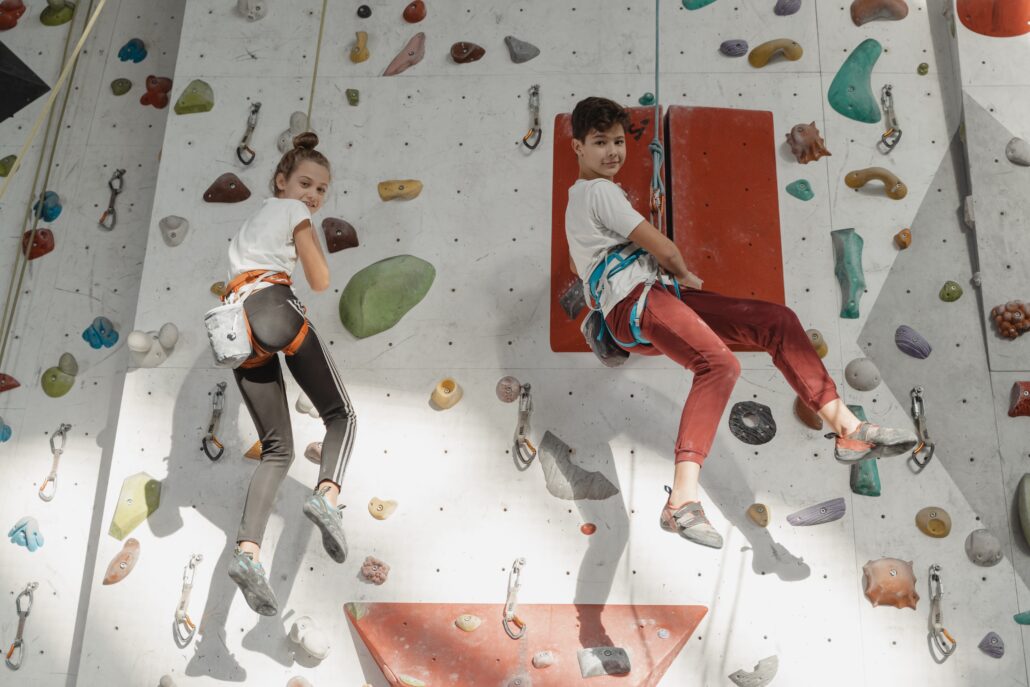
19. Rock Climbing
Rock climbing c an be an exciting and innovative activity to add a physical activity lesson for elementary students . It’s an activity that not only boosts physical strength and endurance but also helps students to build their problem-solving skills.
One perfect way to introduce rock climbing to students is by adding to your course equipment a bouldering wall in the gymnasium or in an outdoor space. Start by teaching students the basic techniques of climbing and bouldering , like footwork and handholds, and progress to more difficult courses as they earn experience and confidence.
As a teacher , you can also use a portable climbing wall that can be easily set in any space . Those walls are made to be perfectly safe and user-friendly for children and can be adapted to all skill levels and ages.
However, keep in mind that this sport is a bit more dangerous and demanding that’s why proper supervision and equipment should always be in place . By using a climbing wall you will help students to develop both physical and mental skills.
20. Scooter Board Activities
Scooter boards are small boards with wheels that can be used for a variety of physical activities . Scooter board activities can be an innovative lesson to add to your physical education lesson plan as elementary students can be taught valuable skills like balance, coordination and teamwork skills . There are many scooter board activities that can suit all skill levels and ages.
Some famous scooter board activities are relay races, obstacle courses, and target games . For relay races, students can contest in teams and check who can finish the course in the fastest time, while also sitting or lying on the small scooter boards.
Obstacle courses can be set up using cones, hurdles, and other tools to challenge students’ balance and motion skills. Target games can include actions like rolling a ball or beanbag onto a target while seating on a scooter board.
Scooter board activities can be adjusted for all ages and skill levels . They are a versatile option for physical education teachers who are tired of using the same traditional games.
They can be utilises as an exciting break from classic sports and games , while still providing useful physical activity and skill development opportunities.

21. Sack Races
Sack races are a classic physical activity that elementary school students can participate in and have fun while exercising . This activity involves students standing inside a large sack or pillowcase and jumping toward a finish line .
A student wins the race if he or she crosses the finish line first . Everything is a matter of speed, balance and coordination skills
A sack race is not only a fun and entertaining activity, but it can also provide a number of physical perks . The purpose of sack games is to develop fine control skills, coordination, balance, and leg strength. The distance and size of the sacks can also be adjusted for students of different ages and skill levels.
For a more challenging activity, you can use obstacles such as cones or hoops and let students race through them . Relay races can also be incorporated, where students pass the sack to each other before sprinting to the finish line. Generally, sack races can be a great way to get elementary students active and involved in physical education.
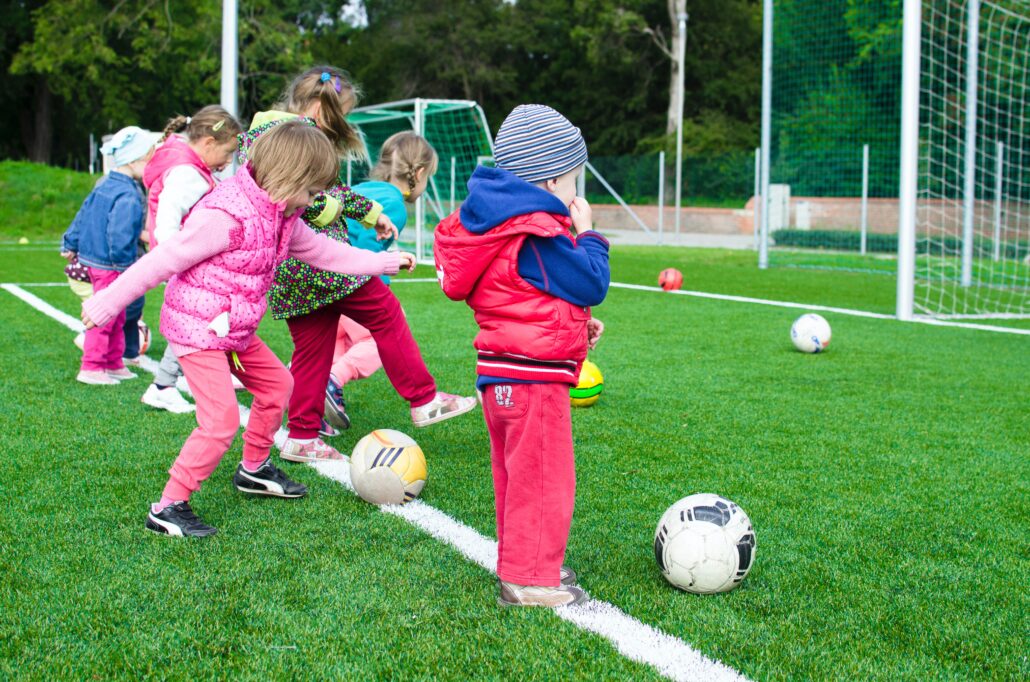
22. Kickball
Kickball is a traditional physical education activity that is used in elementary schools for years. Kickball is a simple twist of the classic baseball game.
The game involves kicking a large rubber ball instead of the traditional baseball one. T he game is played outdoors with four bases and a pitcher, and the purpose is to score runs by running around the bases after kicking the ball.
Kickball is an amazing activity that helps students grow their fitness levels and physical skills, like strength and agility. It is a game that also promotes more personal skills like teamwork and sportsmanship , as students must play together to win the game while following the rules.
If you want to make the game more difficult there are plenty of variations that can be added. Apply some different rules for the base running or use different types of balls. Kickball games can be played in indoor and outdoor spaces making it an excellent choice for all elementary schools.
23. Wall Ball
Wall Ball is an easy and exciting activity for elementary school students that can be played both indoors and outdoors . It is an amazing way to enhance hand-eye coordination, throwing and catching skills, and overall fitness.
The game involves throwing a ball against a wall and catching it before it hits the ground or bounces off in an unexpected direction. Students can play this game individually or in teams, and the rules can be changed based on their age and skill level.
Wall Ball can be played with different types of balls such as tennis balls, rubber balls, or foam balls. It is an easy and accessible game that requires minimal equipment and can be adapted to fit the available space and resources.
Wall Ball also provides a chance for children to engage in friendly competition and practice sportsmanship. With the proper equipment and supervision, Wall Ball can be a safe and enjoyable activity for elementary students of all skill levels.
24. Topple Tube
Topple Tube encourages teamwork and strategic thinking through fun and engaging gameplay. Students must be divided into teams in order to play the game. Each team must flip its coloured cups to be on top of its opponents’ coloured cups in order to win the game. The cups are placed on top of tall poles or tubes, making it challenging for players to reach them.
In this game, two teams are formed, and each team is given a set of cups of a specific colour. Afterwards, the players scatter around the playing area, flipping cups to the colours of their teams. Depending on the equipment available, you can use either plastic cups or wooden blocks with different colours on each end.
In order to flip the cups effectively, the players must strategize and communicate with each other. To succeed in the game, they must also be quick on their feet and have good hand-eye coordination. By the end of the game, the team with the most cups flipped to the colour of their team wins.
The Topple Tube is an excellent physical education activity for elementary school students. As well as promoting physical activity and hand-eye coordination, Topple Tube promotes teamwork, communication, and strategic thinking skills.
25. Portable Balance Games
Portable balance games are a great way to challenge elementary school students’ balance and coordination skills. To play the games you only need some buckets in order to create the course and place them upside-down .
The upside-down buckets can be modified to fit students of all skill levels since they can walk along them at their own pace. If you want to make the activity more challenging, arrange the buckets in a zig-zag or curvy pattern . In order to navigate the bucket course, students will need to use their balance and gross motor skills in different ways.
Another great feature of portable balance games is that they can be positioned indoors or outdoors . As a result, it is an excellent option on days when the weather may prevent outdoor activities or for classrooms with limited space.
In addition, the buckets are a low-cost and convenient option for physical education lessons on a budget since they can be easily stacked and stored.
In conclusion, physical education is a critical element of a well-rounded education. It encourages physical exercise, teamwork, sportsmanship, and overall health and wellness . With the increasing prevalence of technology and passive lifestyles, it is more important than ever to foster children to engage in physical activity.
The 25 elementary physical education lesson plans listed above are just a few examples of the many activities and games that can be used to boost physical activity and learning. As an instructor though you can form your own lesson plans based on the requirements and interests of your students.
By making physical education fun and engaging, we can help children create a lifelong love of physical activity and healthy living . Let’s continue to prioritize physical education in our schools and communities, and encourage children to lead healthy, active lives.

Jessica Elrajan
Jessica Elrajan has been in the field of education for the past decade. She has taught all grade levels from Kindergarten through 5th grade (and some twice!). Jessica also wrote an ELA Curriculum for Elementary school students that has been implemented district-wide for six international schools in Asia and the Middle East. More about Jessica
- Our Content
- Success Stories
- Schedule A Demo
- Login / Register
Gymnastics Lesson Plans
- Doug Curtin
- April 22, 2024

Gymnastics lesson plans offer an introduction to the basic components of gymnastics skills. Students can practice and develop body control, balance, mobility, strength, and more through the fun and exciting sport of gymnastics. We break down the what, why, and how of introducing gymnastics lesson plans to students.
Gymnastic Lesson Plans Don’t Need To Be Complicated!
When it comes to preparing for gymnastics lesson plans in physical education, you don’t need an Olympic style set up from pommel horses to parallel bars. Instead, PE teachers can introduce basic gymnastics skills in just about any gymnasium or space.
By keeping things simple, PE teachers can introduce students to the basic elements of gymnastics with some soft mats, balance beams (or even lines painted on the floor), and boxes or other elevated surfaces.
At PLT4M, we recommend teaching gymnastic skills to the entire class allowing ample students time to practice the movements together. From here, teachers can create stations where students can spread out into smaller groups and practice different types of exercises.
As always, PE teachers can use their discretion and experience to determine what structure and format makes the most sense for their class and audience.
Skills For Gymnastics Lesson Plans
Just like our equipment, the skills we introduce in PE lessons can be simple, yet fun and impactful. Mirrored from many introductory gymnastics classes, PLT4M taps into the following 6 categories during gymnastics lessons.
Gymnastics lesson plans can include:
Flexibility
Within each category, students can move in different ways, finding the right fit and challenge for their experience and ability. Let’s take a closer look at a drill example from each of the 6 categories.
6 Examples From Gymnastics Lesson Plans
Below are 6 different exercise examples from PLT4M’s gymnastics lesson plans.
Each exercise has written and video instruction. We recommend taking about 10 minutes on any drill to introduce the skill and allow time for students to practice.
Teachers can pair and match different drills depending on total class time. In addition, students will benefit from reviewing and repeating drills over multiple classes to really fine tune their gymnastic skills. Eventually, teachers can create different stations for more independent practice and development.
1) Crawls – Bear
Starting gymnastics lesson plans with crawls via a warm-up is a popular choice for PE teachers because it helps students develop the basic skills of transferring weight between feet and hands. Below is the bear crawl with written notes and instructions!
- Start with your feet shoulder width apart. Students can bend knees or bring legs further apart to modify the difficulty of the movement.
- Bring your hands out in front of you and lean your weight forward so that you can begin to travel forward. Think biceps by the ears!
- Move with opposite hand and leg as you travel forward.
2) Tumbling – Forward Roll
For all of our tumbling movements in gymnastics lesson plans, we want to move with control. Slow things down so that you can perform these movements with great form and technique! Always use soft surfaces when practicing tumbling.
- Start with your feet together and arms pressed overhead with your biceps hugging your ears.
- Bend down placing your slightly out in front of you on the ground.
- Tuck your chin to your chest as you let your body roll over.
- Do your best as you finish your roll to come to a standing position with your feet together. Option to modify the movement by bringing your feet further apart.
- Stay controlled throughout this motion. We want to keep our body rounded and avoid flopping over.
3) Jumps – Straight Jump with 180 Spin
When performing any of our jump movements in gymnastics lessons, we don’t need a lot of elevation to be successful. The goal with all of our jumping movements is to learn how to jump and land safely. Only allow students to add height so long as they are maintaining the points of performance of the jump and land techniques. For jumps you can use boxes, steps, or even gymnasium bleachers
- Start with your feet hip distance apart on the box.
- Bend your knees, hips back, and swing your arms backward.
- As you go to jump, extend your knees and ankles as you swing your hands up.
- Now, as you go into the air twist half way, squeezing your core to stay tall and strong.
- Land softly with your knees bent, hips back, and arms out in front of you.
- Avoid landing with straight legs or knees caving forward or sideways.
4) Beam – Tip Toe Forward
There are lots of options when it comes to performing the beam exercises during gymnastics lesson plans. If you have a soft beam or slightly elevated beam that is great. But all beam exercises can also be achieved by using any of the painted lines on the gym floor or by putting down a line of tape. In fact, we strongly recommend beginner students all starting off the beam and on a line before trying movements on the beam itself!
- Start with one foot in front of the other on your beam/line.
- Raise up onto your toes and and lift your arms overhead. Option to keep your arms by the side in a T position to help with balance.
- Squeeze your belly and butt as you walk to the other end of the beam/line.
- A nice trick is to spot or look at the other end of the beam/line to help with balance.
5) Holds – Tuck
With all of our holds, encourage students to keep their hold position for 5-10 seconds to start. As students progress in gymnastics lesson plans, the goal is to extend our time on the hold from 10, to 20, to 30 seconds if possible. Teachers can set the goal times based on the group they are working with!
- Start seated on the ground with hands right behind your bum.
- Bring your knees together and lift them up to create a 90 degree angle.
- Squeeze your core to hold yourself in the tuck position.
- If you want to make this hold more challenging, take your hands off the ground and point them straight out in front of you and work to stay balanced.
6) Flexibility – Pike
With all of our flexibility movements in gymnastics lesson plans, encourage students to keep their hold position for 10-15 seconds to start. As students progress, the goal is to extend our time on the hold from 10, to 20, to 30 seconds if possible. Teachers can set the goal times based on the group they are working with!
Key Takeaways on Gymnastics Lesson Plans
Gymnastics lessons can be an excellent addition for elementary and middle school physical education classes! There are no advanced skill requirements for students to start with the basics of gymnastics.
As you look for the right gymnastic lessons resources, look no further than PLT4M to build out your gymnastic classes. These 6 sample videos are just a taste of the full slate of resources within the PLT4M library that help PE teachers:
Introduce lifelong fitness skills using high quality resources and instructional materials
Hit state and national standards within gymnastics and other fitness, health, and wellness skills
What other types of lesson plans and workouts does PLT4M have?
Consider PLT4M your full learning management system for health and physical education.
PLT4M has a full slate of PE lessons for physical education teachers to choose from! From PE games to fitness activities, PLT4M has countless options. Check out some of the most popular below:
- Weight Training
- Dance Fitness
- Mindfulness
- Remote Learning
- Personal Hygiene
- Drug and Substance Education
- Physical Literacy
- Social Emotional Learning
- Health Education Lesson Plans
Share this article:
Recent Posts

Treadmill Running Workouts For Students

Lifetime Fitness Activities
Interested if PLT4M can work at your school?

At Stockbridge JR/SR High School, students from all grade levels come to the weight room with different experiences, interests, and abilities. How do they ensure that all students leave feeling personal achievement, and keep them coming back every year?

Building A Successful 7th-12th Grade Weight Training Program
Stockbridge Junior Senior High School has developed a 7th-12th weight training program that is building a sense of success in all students.
What does Lifetime Fitness Activity mean in your Physical Education curriculum? What activities do you expose students to, and why?

Lifetime fitness activities in physical education can support lifelong fitness, health, and wellness. See how!
At this HS, PE students can choose from a range of fitness activities - options like weightlifting, yoga, boxing, pilates, and bootcamp. Encouraging exploration & choice, it empowers them with the skills and confidence for a lifetime of health & wellness.

Student Choice in PE Leads To School-Wide Success
How does a school increase the motivation and excitement around physical education? Hutsonville does it by empowering student choice!
How does a high school Physical Education department transition from primarily a games-based program to a more fitness-focused curriculum?

Fitness-Focused Phys Ed At Hammond Central
After obtaining a grant to invest in curriculum and technology, Hammond Central has seen success with fitness-focused phys ed!
get.plt4m.com
With SEL playing a more prominent role in the crafting of physical education curriculum, how do you go about addressing mental health by way of emotion?

Lesson Plans On Emotions For Middle and High School Students
We discuss the importance of teaching social-emotional development in middle and high schools and provide 3 sample lesson plans on emotions.
How did one high school place students, with their own personal goals and choices, at the center of the approach to Physical Education?

Student-Centered Strength And Fitness Classes
Littlestown High School in Pennsylvania is seeing the positive results of student-centered learning in Strength and Fitness classes.

- Browse By Category
- View ALL Lessons
- Submit Your Idea
- Shop Lesson Books
- Search our Lessons
- Browse All Assessments
- New Assessments
- Paper & Pencil Assessments
- Alternative Assessments
- Student Assessments
- View Kids Work
- Submit Your Ideas
- Browse All Best Practices
- New Best Practices
- How BPs Work
- Most Popular
- Alphabetical
- Submit Your Best Practice
- Browse All Prof. Dev.
- Online PD Courses
- Onsite Workshops
- Hall of Shame
- Becoming a PE Teacher
- PE Articles
- Defending PE
- Substitute Guidelines
- Online Classes
- PE Research
- Browse All Boards
- Board of the Week
- Submit Your Bulletin Board
- Browse All Class Mngt
- Lesson Ideas
- New Teacher Tips
- Reducing Off-Task Behavior
- Browse All Videos
- Find Grants
- Kids Quote of the Week
- Weekly Activities
- Advertise on PEC
- FREE Newsletter
PE Central has partnered with S&S Discount Sports to provide a full range of sports and PE products for your program.
Get Free Shipping plus 15% OFF on orders over $59! Use offer code B4260. Shop Now!
- Shop Online Courses:
- Classroom Management
- Integrating Literacy & Math
- Grad Credit
- All PE Courses

- Cooperative Fitness Challenge
- Cooperative Skills Challenge
- Log It (Activity Tracker)

- Instant Activities
- Grades 9-12
- Dance of the Month
- Special Events Menu
- Cues/Performance Tips
- College Lessons
- Search All Lessons

- Paper & Pencil Assessments
- Shop Assessment

- How BP's Work

- Shop Bulletin Board Books

- Apps for PE Main Menu
- Submit Your App
- Ask our App Expert
- Active Gaming

- What is Adapted PE
- Ask Our Expert
- Adapting Activities
- IEP Information
- Adapted Web Sites
- Shop Adapted Store

- PreK Lesson Ideas
- PreK Videos
- Homemade PreK PE Equip
- Shop PreK Books

- Shop Class Mngt Products

- Search Jobs
- Interview Questions
- Interview Tips
- Portfolio Development

- Becoming PE Teacher
- Fundraising/Grants

- New Products
- T-Shirts/Accessories
- Class Management
- Middle School
- High School
- Curriculums
- Limited Space

- Search Our Lessons

Name of Activity:
Balancing Act!
Purpose of Activity:
Prerequisites:, suggested grade level:, materials needed:.
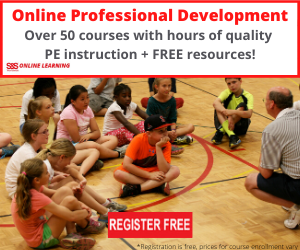
Description of Idea
Station 1 6 x 6� area Station 2 Lay ropes in a line, circle, and square Station 3 Spread out mats Station 4 Lay polyspots in a random pattern Station 5 Set the balance beam low Station 6 Spread out pool noodles Station 7 Spread out mats Station 8 (Beanbags)
Divide students in groups of 3 and assign each to a station. Demonstrate activity at each station before beginning. Provide 2-3 minutes for students to complete balance challenges before signaling them to move on to another station. (Rotate in order)
Balancing Act Checklist
Assessment Ideas:

Previous Comments:
PE Central� Copyright � 1996-2020 All Rights Reserved

PE Central � 2516 Blossom Trl W Blacksburg, VA 24060 E-mail : [email protected] Phone : 540-953-1043 Fax : 540-301-0112
Copyright � 1996-2016 PE Central® www.pecentral.org All Rights Reserved Web Debut : 08/26/1996

IMAGES
VIDEO
COMMENTS
8 Stations are set up around the gym. Station 1: Tennis - Balance the tennis ball on the racket. See what you can do while balancing it. (sit down, stand up, walk, jump, spin) Station 2: Balance Boards. Station 3: Bean Bag Body Balance - Balance bean bags on your body. Try to move around while balancing them.
Attend physical education class, have fun, and stay healthy and safe. Play Balance Pathway with a family member. Complete Weekly Physical Activity Log (60 minutes of daily activity). WEEK 4 Attend physical education class, have fun, and stay healthy and safe. Practice the Balloon Bop Challenge for at least 5 minutes per day.
Movements crossing mid-line and in opposition. Non dominant eye or hand activities. Increase muscular strength and endurance. Postural control skills. Unstable surfaces. Unstable swings and moving. Here are some examples of exercises and progressions that stress and can improve balance. Push Ups.
Balance Lesson Plan for Physical Education. John has tutored algebra and SAT Prep and has a B.A. degree with a major in psychology and a minor in mathematics from Christopher Newport University ...
Discover the untapped potential of balance and kinesthetic awareness in physical education with this insightful article. Learn how these skills extend beyond the gym, impacting daily life and recreational activities. Gain practical tips and effective techniques for integrating balance and kinesthetic awareness into your PE curriculum, fostering holistic growth and boosting student confidence.
The responses should include knees, hands, elbows, feet, tummy, back, seat, etc. Remind students to keep their weight over their "bases of support" and try and hold their balance still for 5 seconds. Demonstrate what a partner balance might look like. Divide students into pairs and challenge them to work cooperatively to create and design ...
Activity #3: Finger Touch. •Directions: stand with feet shoulder width apart. Place one hand behind your back with your pointer finger pointing down. Reach around your back with the other hand and grab the wrist of the first hand. Now try to squat down and touch the floor with the pointed finger without falling over.
"The Dynamic PE ASAP website is by far the best resource or tool available for elementary and secondary physical education programs. It is a free resource that has lesson plans (four part- Intro., fitness, skill focus & game), sample videos demonstrating on how to do and meets the SHAPE American and State content standards.
ABC - Agility, Balance and Coordination 30 Lesson Unit Plan Designed as a 6 week unit plan with 5 daily 30 minute physical education classes per week Grade level focus: grade 3 and grade 4 (unit can be easily adapted to middle or high school) Unit Overview First 10 Lessons focused on Balance:
Browse Activities and Create Your Complete Lesson Plan. Login Signup. We use cookies to give you a better website experience. ... I can balance and transfer weight while using a balance... K-2. Lesson Focus. 1. ... I can discuss one physical education concept demonstrated while playing... 5-8. Closing Activity. 2 3 4.
A physical education balance lesson plan: Use this Daily Move: Balance pack to help your class improve their balancing skills. The Daily Move is a specially-designed fitness program for children which focuses on a different physical skill or key activity each half-term. The program provides fun and engaging activities, which are easy to carry ...
Physical education prepares children for an active and healthy life while improving self discipline and reducing stress. This section includes PE lessons from kindergarten through high school spanning different skill levels and objectives. Lessons are categorized by grade for easy retrieval. These lessons were created by real teachers working ...
Have students examine their shape boards and become familiar with the different shapes. Give the students directions to balance on the different shapes. At first, allow the students to balance any way they wish. Stop and discuss the different ways they choose to balance. Different balances can include balancing on their right foot, balancing on ...
This physical education balance lesson plan is all you need to prepare and complete a lesson on the topic of balance. Our resource is an easy-to-download pack, that you can access by clicking on the green button above. It consists of a PowerPoint presentation, useful warm-up activities, a balance assessment and recording sheet, weekly balance ...
This physical education balance lesson plan is all you need to prepare and complete a lesson on the topic of balance. Our resource is an easy-to-download pack, that you can access by clicking on the green button above. It consists of a PowerPoint presentation, useful warm-up activities, a balance assessment and recording sheet, weekly balance ...
3. Yoga. Yoga poses can be a fun and engaging way to promote physical activity and mindfulness in elementary school students.It has been proven that yoga is beneficial to both mental and physical health, including increasing flexibility, strength, and balance, and reducing stress.Here is an example of a basic yoga sequence that can be used with elementary school students:
The teacher can also place 2-3 pictures on a 1/2 sheet of paper and ask the students to circle the balances that represents the concept you are assessing (i.e. symmetrical balance). Teaching Suggestions: Multiple lessons can be formed by using the educational gymnastics power point on PE Central as a guide. Spotting should not be required.
5) Holds - Tuck. With all of our holds, encourage students to keep their hold position for 5-10 seconds to start. As students progress in gymnastics lesson plans, the goal is to extend our time on the hold from 10, to 20, to 30 seconds if possible. Teachers can set the goal times based on the group they are working with!
Physical Education 5th Grade Unit 1 Lesson Plan 1 Georgia Department of Education Page 5 of 61 ... cooperation, balance, exercising, cardiovascular endurance VOCABULARY: Cooperation, lily pad, strategy, timing, habitat ... Physical Education 5th Grade Unit 1 Lesson Plan 1 Georgia Department of Education Page 7 of 61 I am shy
Description of Idea. Use cones to designate station areas and prepare each area for activity. Station 1 6 x 6' area. Station 2 Lay ropes in a line, circle, and square. Station 3 Spread out mats. Station 4 Lay polyspots in a random pattern. Station 5 Set the balance beam low. Station 6 Spread out pool noodles. Station 7 Spread out mats.
Sample First Lesson Plan 29 Academic Language Posters 82pages ... • Standard 3 [E2.3-5]: Engages in the activities of physical education class without teacher prompting (3); Actively engages in the activities of physical education class, ... Asymmetrical, Balance, Base of Support, Bend, Curl, Dynamic, Endurance, Extend, Flex, Flexibility ...